Business Decision Making Analysis
VerifiedAdded on 2020/01/15
|25
|5175
|117
AI Summary
This assignment delves into the complexities of business decision making. It requires students to apply quantitative techniques such as correlation analysis to understand the relationship between various factors impacting decisions. The analysis will draw upon real-world case studies and examples, emphasizing the importance of data-driven insights in effective decision-making processes within a business context.
Contribute Materials
Your contribution can guide someone’s learning journey. Share your
documents today.
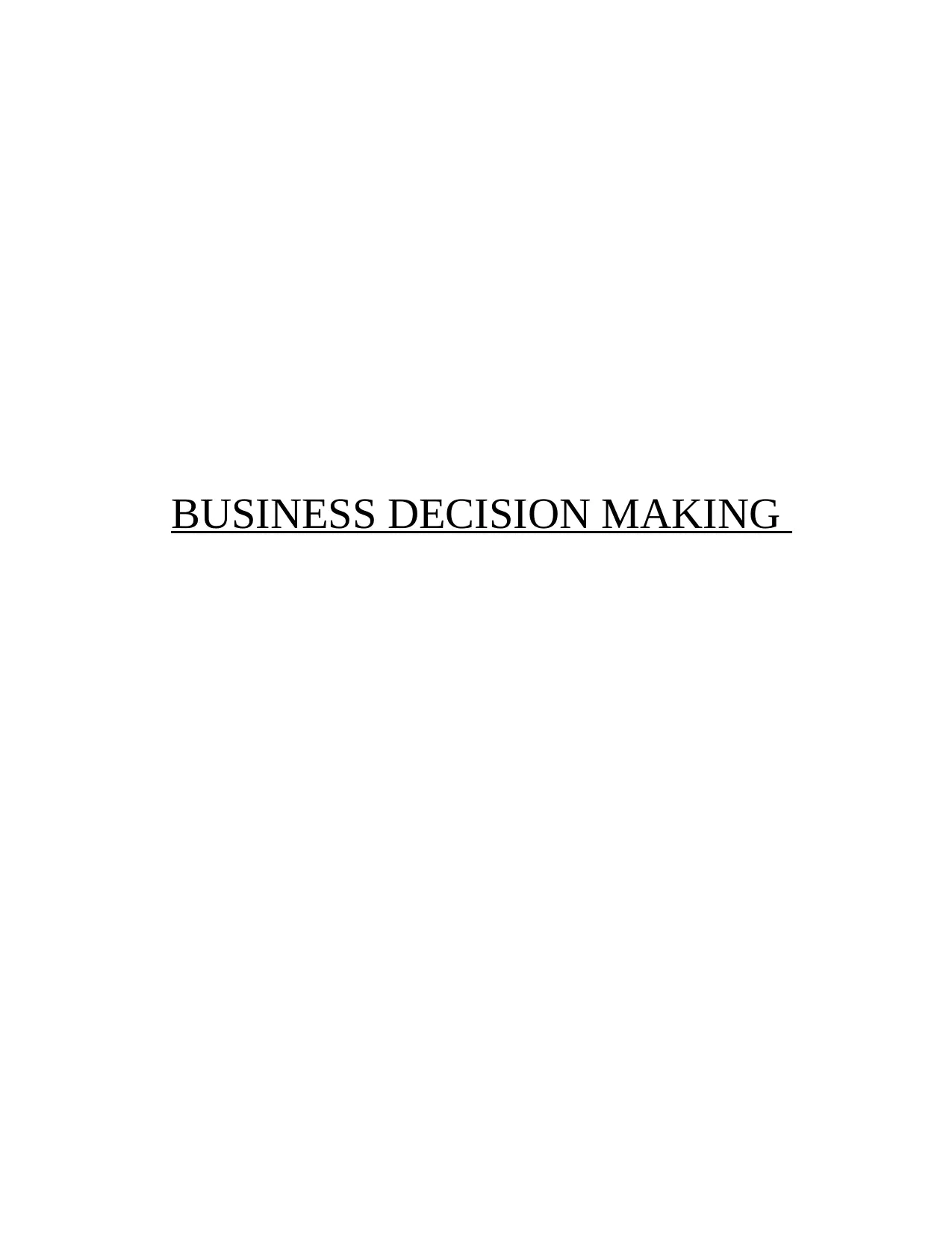
BUSINESS DECISION MAKING
Secure Best Marks with AI Grader
Need help grading? Try our AI Grader for instant feedback on your assignments.
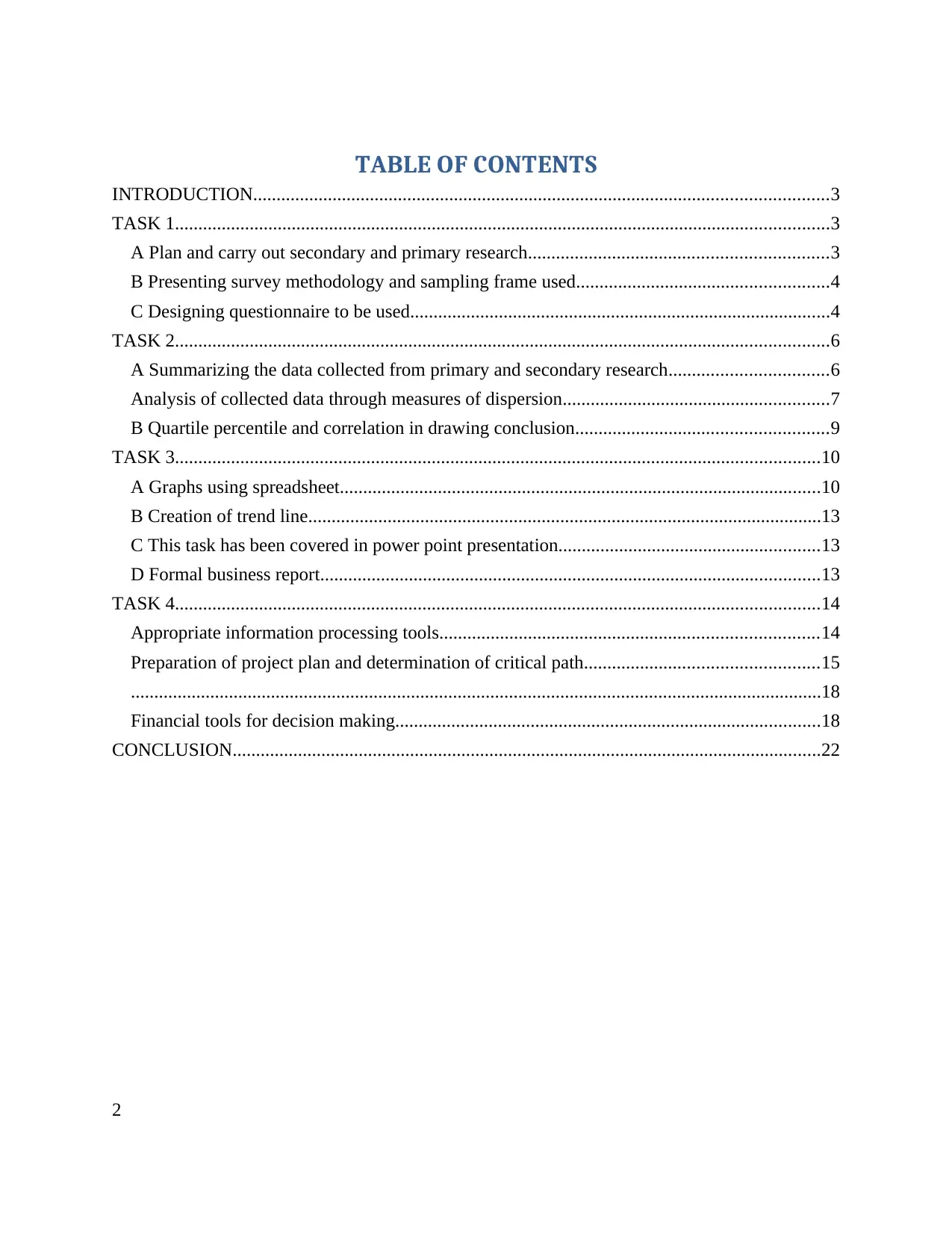
TABLE OF CONTENTS
INTRODUCTION...........................................................................................................................3
TASK 1............................................................................................................................................3
A Plan and carry out secondary and primary research................................................................3
B Presenting survey methodology and sampling frame used......................................................4
C Designing questionnaire to be used..........................................................................................4
TASK 2............................................................................................................................................6
A Summarizing the data collected from primary and secondary research..................................6
Analysis of collected data through measures of dispersion.........................................................7
B Quartile percentile and correlation in drawing conclusion......................................................9
TASK 3..........................................................................................................................................10
A Graphs using spreadsheet.......................................................................................................10
B Creation of trend line..............................................................................................................13
C This task has been covered in power point presentation........................................................13
D Formal business report...........................................................................................................13
TASK 4..........................................................................................................................................14
Appropriate information processing tools.................................................................................14
Preparation of project plan and determination of critical path..................................................15
....................................................................................................................................................18
Financial tools for decision making...........................................................................................18
CONCLUSION..............................................................................................................................22
2
INTRODUCTION...........................................................................................................................3
TASK 1............................................................................................................................................3
A Plan and carry out secondary and primary research................................................................3
B Presenting survey methodology and sampling frame used......................................................4
C Designing questionnaire to be used..........................................................................................4
TASK 2............................................................................................................................................6
A Summarizing the data collected from primary and secondary research..................................6
Analysis of collected data through measures of dispersion.........................................................7
B Quartile percentile and correlation in drawing conclusion......................................................9
TASK 3..........................................................................................................................................10
A Graphs using spreadsheet.......................................................................................................10
B Creation of trend line..............................................................................................................13
C This task has been covered in power point presentation........................................................13
D Formal business report...........................................................................................................13
TASK 4..........................................................................................................................................14
Appropriate information processing tools.................................................................................14
Preparation of project plan and determination of critical path..................................................15
....................................................................................................................................................18
Financial tools for decision making...........................................................................................18
CONCLUSION..............................................................................................................................22
2
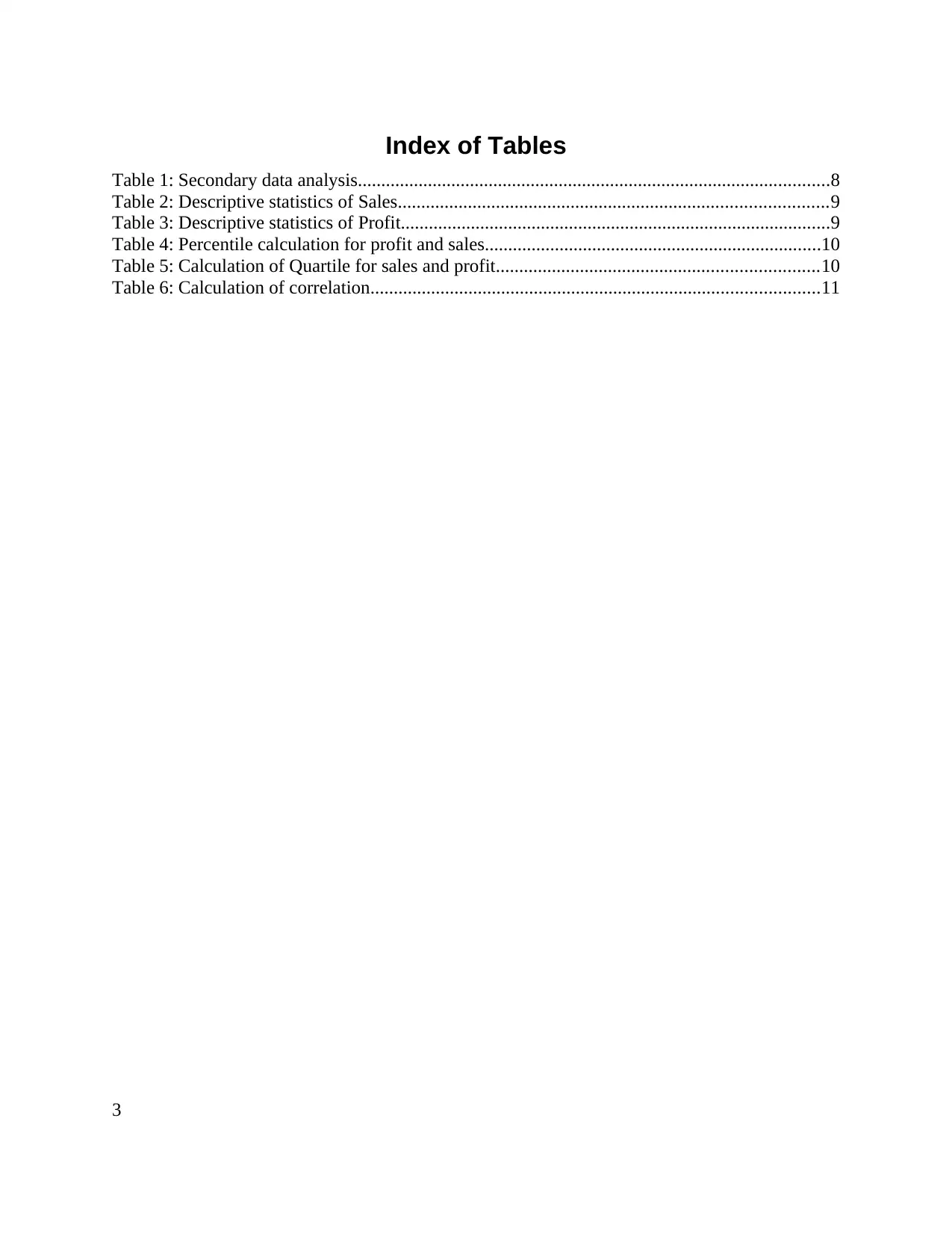
Index of Tables
Table 1: Secondary data analysis.....................................................................................................8
Table 2: Descriptive statistics of Sales............................................................................................9
Table 3: Descriptive statistics of Profit............................................................................................9
Table 4: Percentile calculation for profit and sales........................................................................10
Table 5: Calculation of Quartile for sales and profit.....................................................................10
Table 6: Calculation of correlation................................................................................................11
3
Table 1: Secondary data analysis.....................................................................................................8
Table 2: Descriptive statistics of Sales............................................................................................9
Table 3: Descriptive statistics of Profit............................................................................................9
Table 4: Percentile calculation for profit and sales........................................................................10
Table 5: Calculation of Quartile for sales and profit.....................................................................10
Table 6: Calculation of correlation................................................................................................11
3
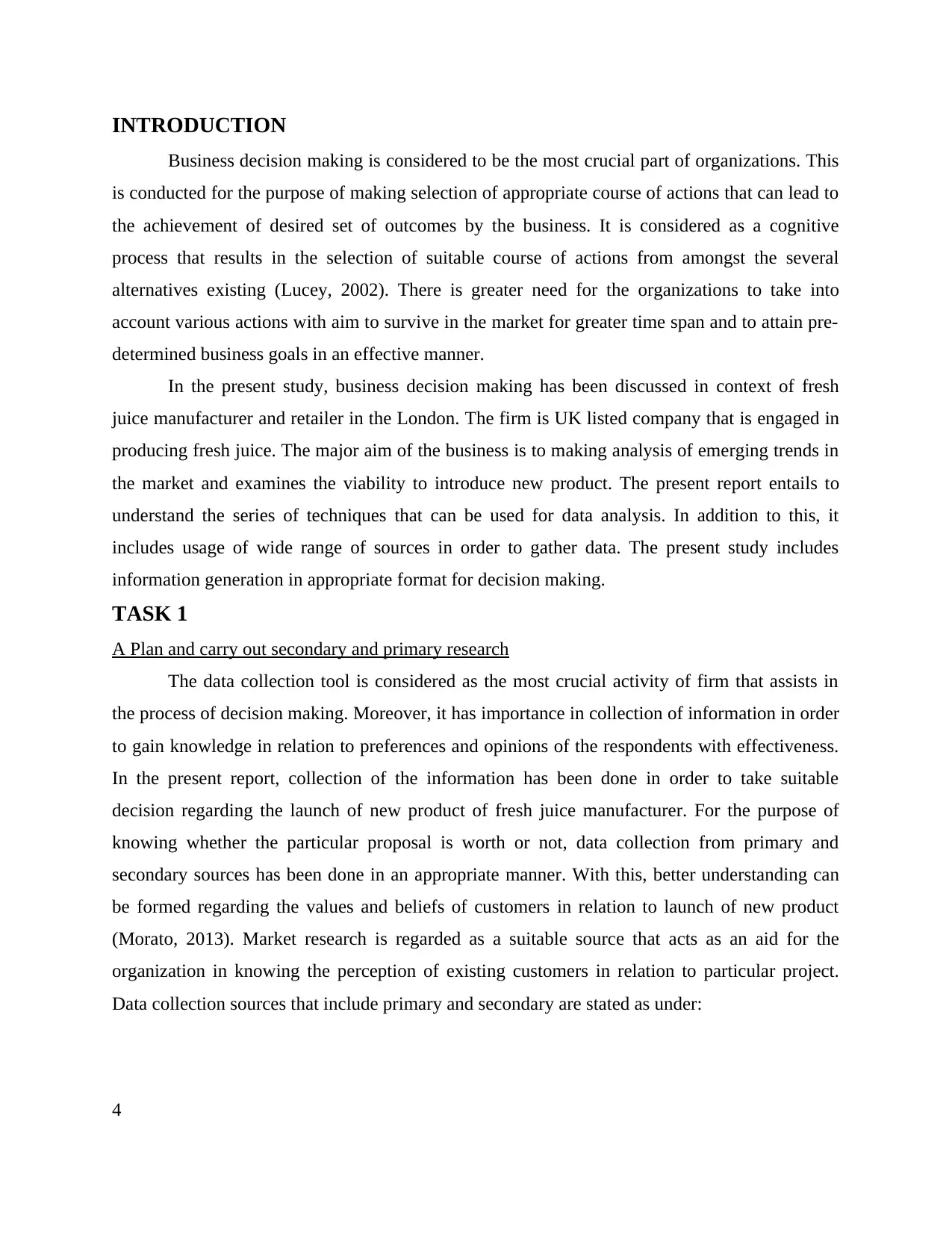
INTRODUCTION
Business decision making is considered to be the most crucial part of organizations. This
is conducted for the purpose of making selection of appropriate course of actions that can lead to
the achievement of desired set of outcomes by the business. It is considered as a cognitive
process that results in the selection of suitable course of actions from amongst the several
alternatives existing (Lucey, 2002). There is greater need for the organizations to take into
account various actions with aim to survive in the market for greater time span and to attain pre-
determined business goals in an effective manner.
In the present study, business decision making has been discussed in context of fresh
juice manufacturer and retailer in the London. The firm is UK listed company that is engaged in
producing fresh juice. The major aim of the business is to making analysis of emerging trends in
the market and examines the viability to introduce new product. The present report entails to
understand the series of techniques that can be used for data analysis. In addition to this, it
includes usage of wide range of sources in order to gather data. The present study includes
information generation in appropriate format for decision making.
TASK 1
A Plan and carry out secondary and primary research
The data collection tool is considered as the most crucial activity of firm that assists in
the process of decision making. Moreover, it has importance in collection of information in order
to gain knowledge in relation to preferences and opinions of the respondents with effectiveness.
In the present report, collection of the information has been done in order to take suitable
decision regarding the launch of new product of fresh juice manufacturer. For the purpose of
knowing whether the particular proposal is worth or not, data collection from primary and
secondary sources has been done in an appropriate manner. With this, better understanding can
be formed regarding the values and beliefs of customers in relation to launch of new product
(Morato, 2013). Market research is regarded as a suitable source that acts as an aid for the
organization in knowing the perception of existing customers in relation to particular project.
Data collection sources that include primary and secondary are stated as under:
4
Business decision making is considered to be the most crucial part of organizations. This
is conducted for the purpose of making selection of appropriate course of actions that can lead to
the achievement of desired set of outcomes by the business. It is considered as a cognitive
process that results in the selection of suitable course of actions from amongst the several
alternatives existing (Lucey, 2002). There is greater need for the organizations to take into
account various actions with aim to survive in the market for greater time span and to attain pre-
determined business goals in an effective manner.
In the present study, business decision making has been discussed in context of fresh
juice manufacturer and retailer in the London. The firm is UK listed company that is engaged in
producing fresh juice. The major aim of the business is to making analysis of emerging trends in
the market and examines the viability to introduce new product. The present report entails to
understand the series of techniques that can be used for data analysis. In addition to this, it
includes usage of wide range of sources in order to gather data. The present study includes
information generation in appropriate format for decision making.
TASK 1
A Plan and carry out secondary and primary research
The data collection tool is considered as the most crucial activity of firm that assists in
the process of decision making. Moreover, it has importance in collection of information in order
to gain knowledge in relation to preferences and opinions of the respondents with effectiveness.
In the present report, collection of the information has been done in order to take suitable
decision regarding the launch of new product of fresh juice manufacturer. For the purpose of
knowing whether the particular proposal is worth or not, data collection from primary and
secondary sources has been done in an appropriate manner. With this, better understanding can
be formed regarding the values and beliefs of customers in relation to launch of new product
(Morato, 2013). Market research is regarded as a suitable source that acts as an aid for the
organization in knowing the perception of existing customers in relation to particular project.
Data collection sources that include primary and secondary are stated as under:
4
Secure Best Marks with AI Grader
Need help grading? Try our AI Grader for instant feedback on your assignments.

Primary data: In this, data is collected by the researcher through means of face to face
interaction with respondents. Survey technique has been used with an aim to collect
information from the existing customers with effectiveness (Montier, 2010). Researcher
has designed the questionnaire for the purpose of getting information regarding
agreement and disagreement of respondents towards the launch of new product for fresh
juice manufacturer.
Secondary data: Under this, collection of information is being done by financials of past.
This involves sales records, annual reports and profitability data. It is important in
providing clear picture regarding the ability of fresh juice manufacturer to launch new
product (Newbold and et.al, 2009). It takes minimal time and efforts in order to gather
information from secondary sources. But, it’s not sure that secondary data provides
accurate and sufficient information in relation to the preferences of existing customers in
relation to plan.
B Presenting survey methodology and sampling frame used
In the present report, in order to gather information, the tool that is survey will be used. In
this, opinions of the customers are collected with assistance of method such as questionnaire.
This involves open ended as well as close ended questions. Open ended question facilitates fresh
juice manufacturer in gaining knowledge regarding the opinions, views and attitudes of
customers for the launch of new product in London project plan. On the other hand, close ended
question restricts the choice of respondents as such question includes multiple choices (Rice,
2007). Thus, there is a boundary created for the existing customers to denote their view points
from the choices provided. In the present study, sampling technique which has been used is
probability sampling. In this, selection of sample is done randomly. This is due to the reason that
it provides equal opportunity to different individuals in getting selected as a part for
investigation. The sample size would be 20. This involves existing customers of fresh juice
manufacturer. Sampling frame is considered as small population unit that demonstrates the
whole population.
C Designing questionnaire to be used
QUESTIONNAIRE
(Kindly take few minutes to provide your responses. Your feedback is appreciated)
5
interaction with respondents. Survey technique has been used with an aim to collect
information from the existing customers with effectiveness (Montier, 2010). Researcher
has designed the questionnaire for the purpose of getting information regarding
agreement and disagreement of respondents towards the launch of new product for fresh
juice manufacturer.
Secondary data: Under this, collection of information is being done by financials of past.
This involves sales records, annual reports and profitability data. It is important in
providing clear picture regarding the ability of fresh juice manufacturer to launch new
product (Newbold and et.al, 2009). It takes minimal time and efforts in order to gather
information from secondary sources. But, it’s not sure that secondary data provides
accurate and sufficient information in relation to the preferences of existing customers in
relation to plan.
B Presenting survey methodology and sampling frame used
In the present report, in order to gather information, the tool that is survey will be used. In
this, opinions of the customers are collected with assistance of method such as questionnaire.
This involves open ended as well as close ended questions. Open ended question facilitates fresh
juice manufacturer in gaining knowledge regarding the opinions, views and attitudes of
customers for the launch of new product in London project plan. On the other hand, close ended
question restricts the choice of respondents as such question includes multiple choices (Rice,
2007). Thus, there is a boundary created for the existing customers to denote their view points
from the choices provided. In the present study, sampling technique which has been used is
probability sampling. In this, selection of sample is done randomly. This is due to the reason that
it provides equal opportunity to different individuals in getting selected as a part for
investigation. The sample size would be 20. This involves existing customers of fresh juice
manufacturer. Sampling frame is considered as small population unit that demonstrates the
whole population.
C Designing questionnaire to be used
QUESTIONNAIRE
(Kindly take few minutes to provide your responses. Your feedback is appreciated)
5
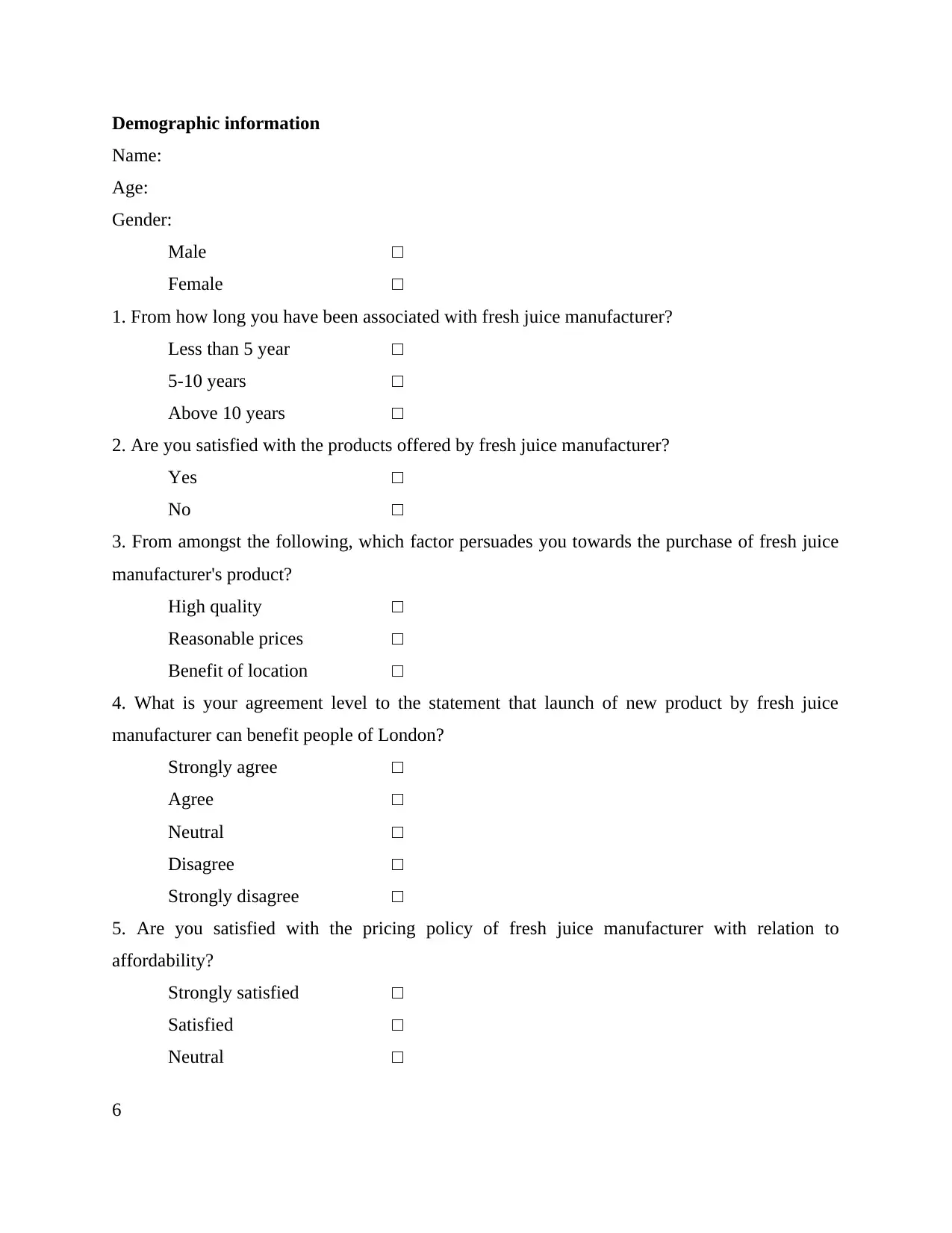
Demographic information
Name:
Age:
Gender:
Male □
Female □
1. From how long you have been associated with fresh juice manufacturer?
Less than 5 year □
5-10 years □
Above 10 years □
2. Are you satisfied with the products offered by fresh juice manufacturer?
Yes □
No □
3. From amongst the following, which factor persuades you towards the purchase of fresh juice
manufacturer's product?
High quality □
Reasonable prices □
Benefit of location □
4. What is your agreement level to the statement that launch of new product by fresh juice
manufacturer can benefit people of London?
Strongly agree □
Agree □
Neutral □
Disagree □
Strongly disagree □
5. Are you satisfied with the pricing policy of fresh juice manufacturer with relation to
affordability?
Strongly satisfied □
Satisfied □
Neutral □
6
Name:
Age:
Gender:
Male □
Female □
1. From how long you have been associated with fresh juice manufacturer?
Less than 5 year □
5-10 years □
Above 10 years □
2. Are you satisfied with the products offered by fresh juice manufacturer?
Yes □
No □
3. From amongst the following, which factor persuades you towards the purchase of fresh juice
manufacturer's product?
High quality □
Reasonable prices □
Benefit of location □
4. What is your agreement level to the statement that launch of new product by fresh juice
manufacturer can benefit people of London?
Strongly agree □
Agree □
Neutral □
Disagree □
Strongly disagree □
5. Are you satisfied with the pricing policy of fresh juice manufacturer with relation to
affordability?
Strongly satisfied □
Satisfied □
Neutral □
6
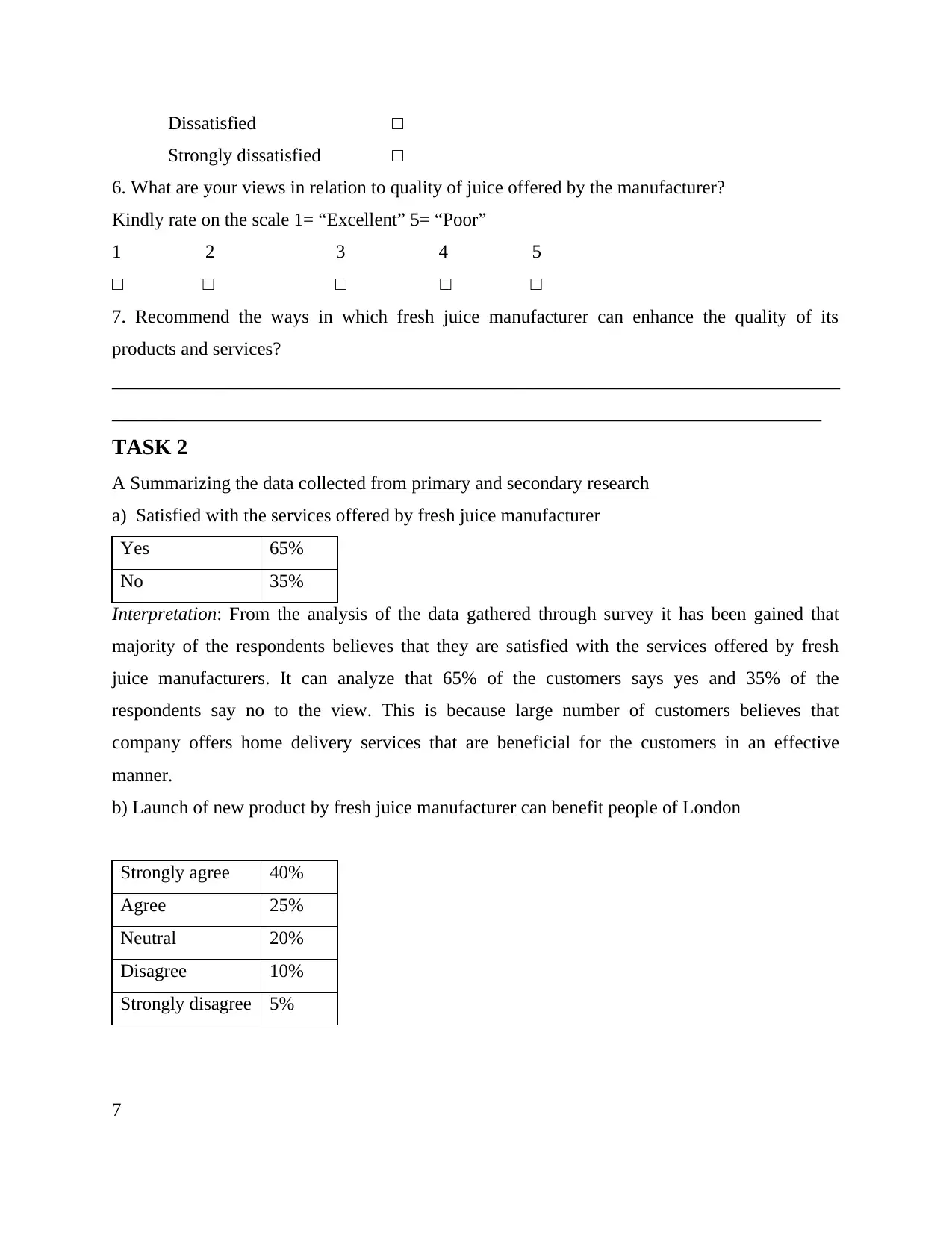
Dissatisfied □
Strongly dissatisfied □
6. What are your views in relation to quality of juice offered by the manufacturer?
Kindly rate on the scale 1= “Excellent” 5= “Poor”
1 2 3 4 5
□ □ □ □ □
7. Recommend the ways in which fresh juice manufacturer can enhance the quality of its
products and services?
______________________________________________________________________________
____________________________________________________________________________
TASK 2
A Summarizing the data collected from primary and secondary research
a) Satisfied with the services offered by fresh juice manufacturer
Yes 65%
No 35%
Interpretation: From the analysis of the data gathered through survey it has been gained that
majority of the respondents believes that they are satisfied with the services offered by fresh
juice manufacturers. It can analyze that 65% of the customers says yes and 35% of the
respondents say no to the view. This is because large number of customers believes that
company offers home delivery services that are beneficial for the customers in an effective
manner.
b) Launch of new product by fresh juice manufacturer can benefit people of London
Strongly agree 40%
Agree 25%
Neutral 20%
Disagree 10%
Strongly disagree 5%
7
Strongly dissatisfied □
6. What are your views in relation to quality of juice offered by the manufacturer?
Kindly rate on the scale 1= “Excellent” 5= “Poor”
1 2 3 4 5
□ □ □ □ □
7. Recommend the ways in which fresh juice manufacturer can enhance the quality of its
products and services?
______________________________________________________________________________
____________________________________________________________________________
TASK 2
A Summarizing the data collected from primary and secondary research
a) Satisfied with the services offered by fresh juice manufacturer
Yes 65%
No 35%
Interpretation: From the analysis of the data gathered through survey it has been gained that
majority of the respondents believes that they are satisfied with the services offered by fresh
juice manufacturers. It can analyze that 65% of the customers says yes and 35% of the
respondents say no to the view. This is because large number of customers believes that
company offers home delivery services that are beneficial for the customers in an effective
manner.
b) Launch of new product by fresh juice manufacturer can benefit people of London
Strongly agree 40%
Agree 25%
Neutral 20%
Disagree 10%
Strongly disagree 5%
7
Paraphrase This Document
Need a fresh take? Get an instant paraphrase of this document with our AI Paraphraser
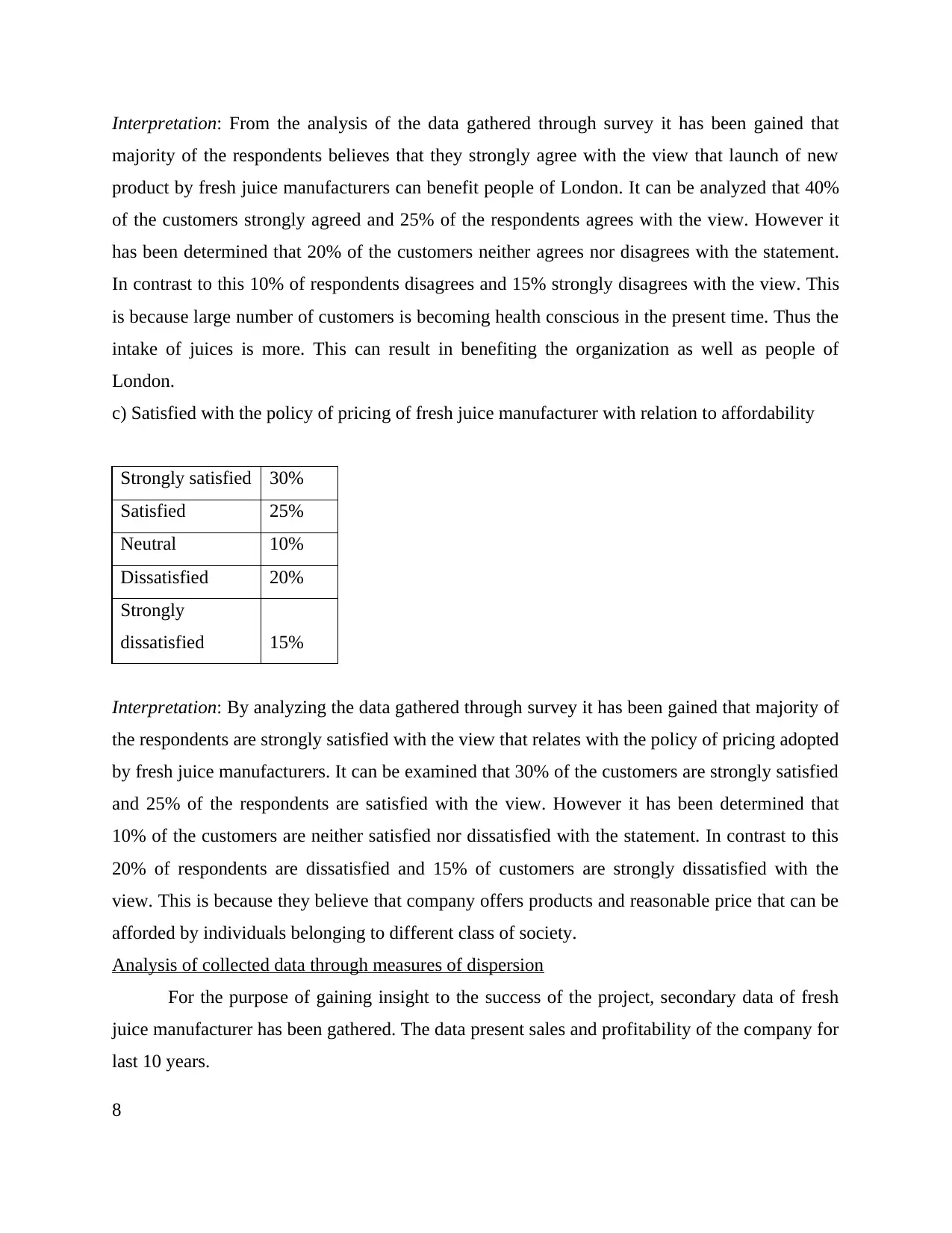
Interpretation: From the analysis of the data gathered through survey it has been gained that
majority of the respondents believes that they strongly agree with the view that launch of new
product by fresh juice manufacturers can benefit people of London. It can be analyzed that 40%
of the customers strongly agreed and 25% of the respondents agrees with the view. However it
has been determined that 20% of the customers neither agrees nor disagrees with the statement.
In contrast to this 10% of respondents disagrees and 15% strongly disagrees with the view. This
is because large number of customers is becoming health conscious in the present time. Thus the
intake of juices is more. This can result in benefiting the organization as well as people of
London.
c) Satisfied with the policy of pricing of fresh juice manufacturer with relation to affordability
Strongly satisfied 30%
Satisfied 25%
Neutral 10%
Dissatisfied 20%
Strongly
dissatisfied 15%
Interpretation: By analyzing the data gathered through survey it has been gained that majority of
the respondents are strongly satisfied with the view that relates with the policy of pricing adopted
by fresh juice manufacturers. It can be examined that 30% of the customers are strongly satisfied
and 25% of the respondents are satisfied with the view. However it has been determined that
10% of the customers are neither satisfied nor dissatisfied with the statement. In contrast to this
20% of respondents are dissatisfied and 15% of customers are strongly dissatisfied with the
view. This is because they believe that company offers products and reasonable price that can be
afforded by individuals belonging to different class of society.
Analysis of collected data through measures of dispersion
For the purpose of gaining insight to the success of the project, secondary data of fresh
juice manufacturer has been gathered. The data present sales and profitability of the company for
last 10 years.
8
majority of the respondents believes that they strongly agree with the view that launch of new
product by fresh juice manufacturers can benefit people of London. It can be analyzed that 40%
of the customers strongly agreed and 25% of the respondents agrees with the view. However it
has been determined that 20% of the customers neither agrees nor disagrees with the statement.
In contrast to this 10% of respondents disagrees and 15% strongly disagrees with the view. This
is because large number of customers is becoming health conscious in the present time. Thus the
intake of juices is more. This can result in benefiting the organization as well as people of
London.
c) Satisfied with the policy of pricing of fresh juice manufacturer with relation to affordability
Strongly satisfied 30%
Satisfied 25%
Neutral 10%
Dissatisfied 20%
Strongly
dissatisfied 15%
Interpretation: By analyzing the data gathered through survey it has been gained that majority of
the respondents are strongly satisfied with the view that relates with the policy of pricing adopted
by fresh juice manufacturers. It can be examined that 30% of the customers are strongly satisfied
and 25% of the respondents are satisfied with the view. However it has been determined that
10% of the customers are neither satisfied nor dissatisfied with the statement. In contrast to this
20% of respondents are dissatisfied and 15% of customers are strongly dissatisfied with the
view. This is because they believe that company offers products and reasonable price that can be
afforded by individuals belonging to different class of society.
Analysis of collected data through measures of dispersion
For the purpose of gaining insight to the success of the project, secondary data of fresh
juice manufacturer has been gathered. The data present sales and profitability of the company for
last 10 years.
8
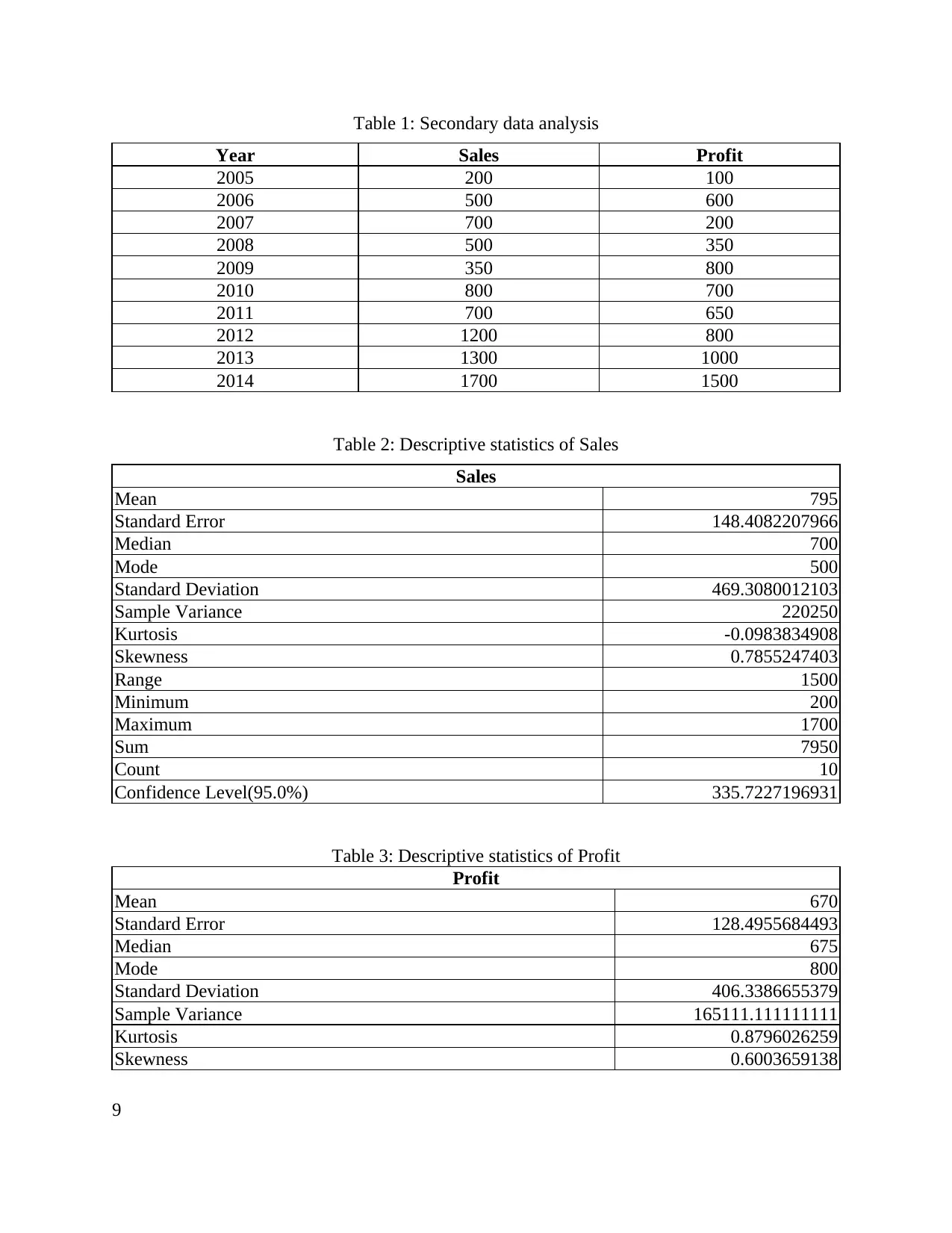
Table 1: Secondary data analysis
Year Sales Profit
2005 200 100
2006 500 600
2007 700 200
2008 500 350
2009 350 800
2010 800 700
2011 700 650
2012 1200 800
2013 1300 1000
2014 1700 1500
Table 2: Descriptive statistics of Sales
Sales
Mean 795
Standard Error 148.4082207966
Median 700
Mode 500
Standard Deviation 469.3080012103
Sample Variance 220250
Kurtosis -0.0983834908
Skewness 0.7855247403
Range 1500
Minimum 200
Maximum 1700
Sum 7950
Count 10
Confidence Level(95.0%) 335.7227196931
Table 3: Descriptive statistics of Profit
Profit
Mean 670
Standard Error 128.4955684493
Median 675
Mode 800
Standard Deviation 406.3386655379
Sample Variance 165111.111111111
Kurtosis 0.8796026259
Skewness 0.6003659138
9
Year Sales Profit
2005 200 100
2006 500 600
2007 700 200
2008 500 350
2009 350 800
2010 800 700
2011 700 650
2012 1200 800
2013 1300 1000
2014 1700 1500
Table 2: Descriptive statistics of Sales
Sales
Mean 795
Standard Error 148.4082207966
Median 700
Mode 500
Standard Deviation 469.3080012103
Sample Variance 220250
Kurtosis -0.0983834908
Skewness 0.7855247403
Range 1500
Minimum 200
Maximum 1700
Sum 7950
Count 10
Confidence Level(95.0%) 335.7227196931
Table 3: Descriptive statistics of Profit
Profit
Mean 670
Standard Error 128.4955684493
Median 675
Mode 800
Standard Deviation 406.3386655379
Sample Variance 165111.111111111
Kurtosis 0.8796026259
Skewness 0.6003659138
9
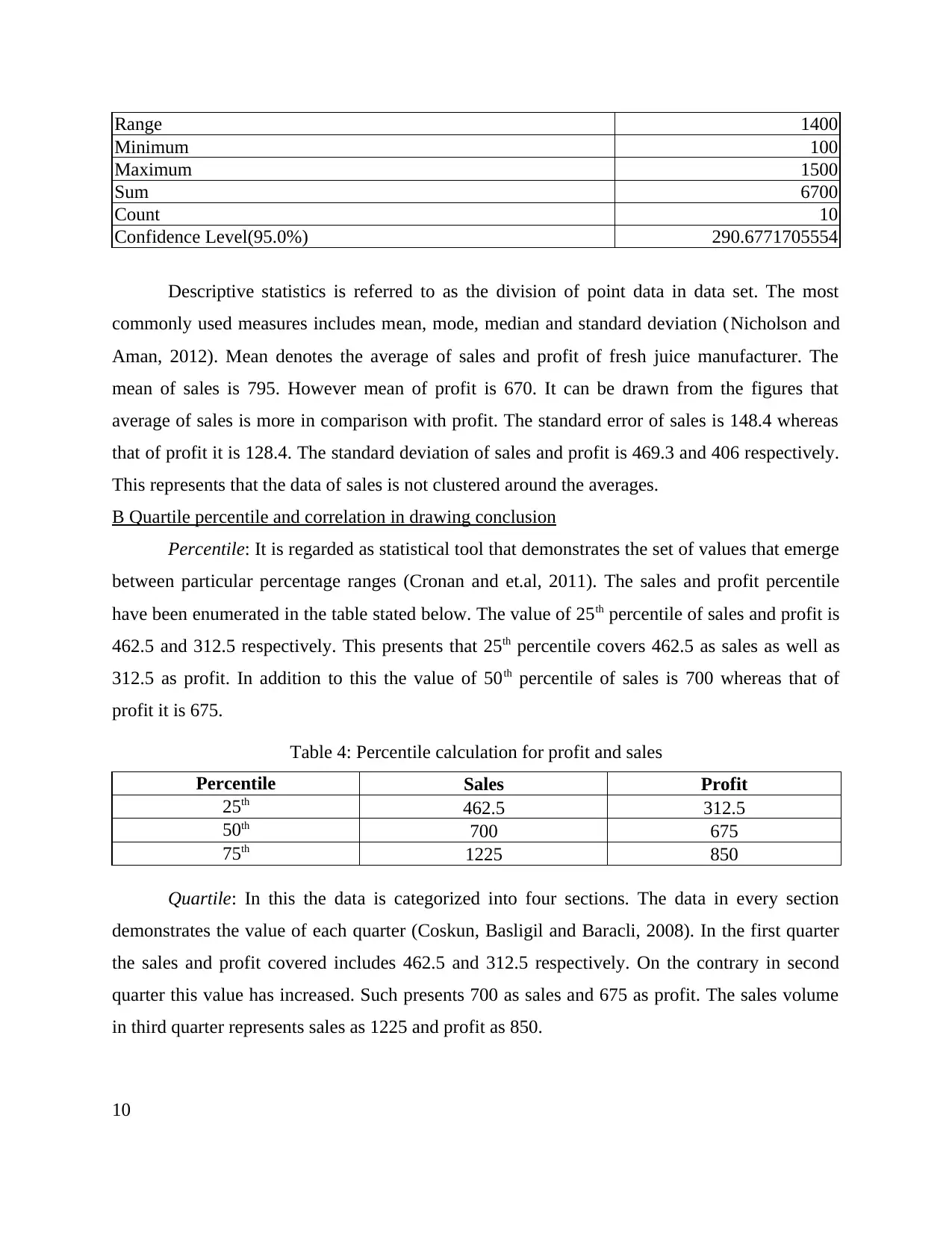
Range 1400
Minimum 100
Maximum 1500
Sum 6700
Count 10
Confidence Level(95.0%) 290.6771705554
Descriptive statistics is referred to as the division of point data in data set. The most
commonly used measures includes mean, mode, median and standard deviation (Nicholson and
Aman, 2012). Mean denotes the average of sales and profit of fresh juice manufacturer. The
mean of sales is 795. However mean of profit is 670. It can be drawn from the figures that
average of sales is more in comparison with profit. The standard error of sales is 148.4 whereas
that of profit it is 128.4. The standard deviation of sales and profit is 469.3 and 406 respectively.
This represents that the data of sales is not clustered around the averages.
B Quartile percentile and correlation in drawing conclusion
Percentile: It is regarded as statistical tool that demonstrates the set of values that emerge
between particular percentage ranges (Cronan and et.al, 2011). The sales and profit percentile
have been enumerated in the table stated below. The value of 25th percentile of sales and profit is
462.5 and 312.5 respectively. This presents that 25th percentile covers 462.5 as sales as well as
312.5 as profit. In addition to this the value of 50th percentile of sales is 700 whereas that of
profit it is 675.
Table 4: Percentile calculation for profit and sales
Percentile Sales Profit
25th 462.5 312.5
50th 700 675
75th 1225 850
Quartile: In this the data is categorized into four sections. The data in every section
demonstrates the value of each quarter (Coskun, Basligil and Baracli, 2008). In the first quarter
the sales and profit covered includes 462.5 and 312.5 respectively. On the contrary in second
quarter this value has increased. Such presents 700 as sales and 675 as profit. The sales volume
in third quarter represents sales as 1225 and profit as 850.
10
Minimum 100
Maximum 1500
Sum 6700
Count 10
Confidence Level(95.0%) 290.6771705554
Descriptive statistics is referred to as the division of point data in data set. The most
commonly used measures includes mean, mode, median and standard deviation (Nicholson and
Aman, 2012). Mean denotes the average of sales and profit of fresh juice manufacturer. The
mean of sales is 795. However mean of profit is 670. It can be drawn from the figures that
average of sales is more in comparison with profit. The standard error of sales is 148.4 whereas
that of profit it is 128.4. The standard deviation of sales and profit is 469.3 and 406 respectively.
This represents that the data of sales is not clustered around the averages.
B Quartile percentile and correlation in drawing conclusion
Percentile: It is regarded as statistical tool that demonstrates the set of values that emerge
between particular percentage ranges (Cronan and et.al, 2011). The sales and profit percentile
have been enumerated in the table stated below. The value of 25th percentile of sales and profit is
462.5 and 312.5 respectively. This presents that 25th percentile covers 462.5 as sales as well as
312.5 as profit. In addition to this the value of 50th percentile of sales is 700 whereas that of
profit it is 675.
Table 4: Percentile calculation for profit and sales
Percentile Sales Profit
25th 462.5 312.5
50th 700 675
75th 1225 850
Quartile: In this the data is categorized into four sections. The data in every section
demonstrates the value of each quarter (Coskun, Basligil and Baracli, 2008). In the first quarter
the sales and profit covered includes 462.5 and 312.5 respectively. On the contrary in second
quarter this value has increased. Such presents 700 as sales and 675 as profit. The sales volume
in third quarter represents sales as 1225 and profit as 850.
10
Secure Best Marks with AI Grader
Need help grading? Try our AI Grader for instant feedback on your assignments.
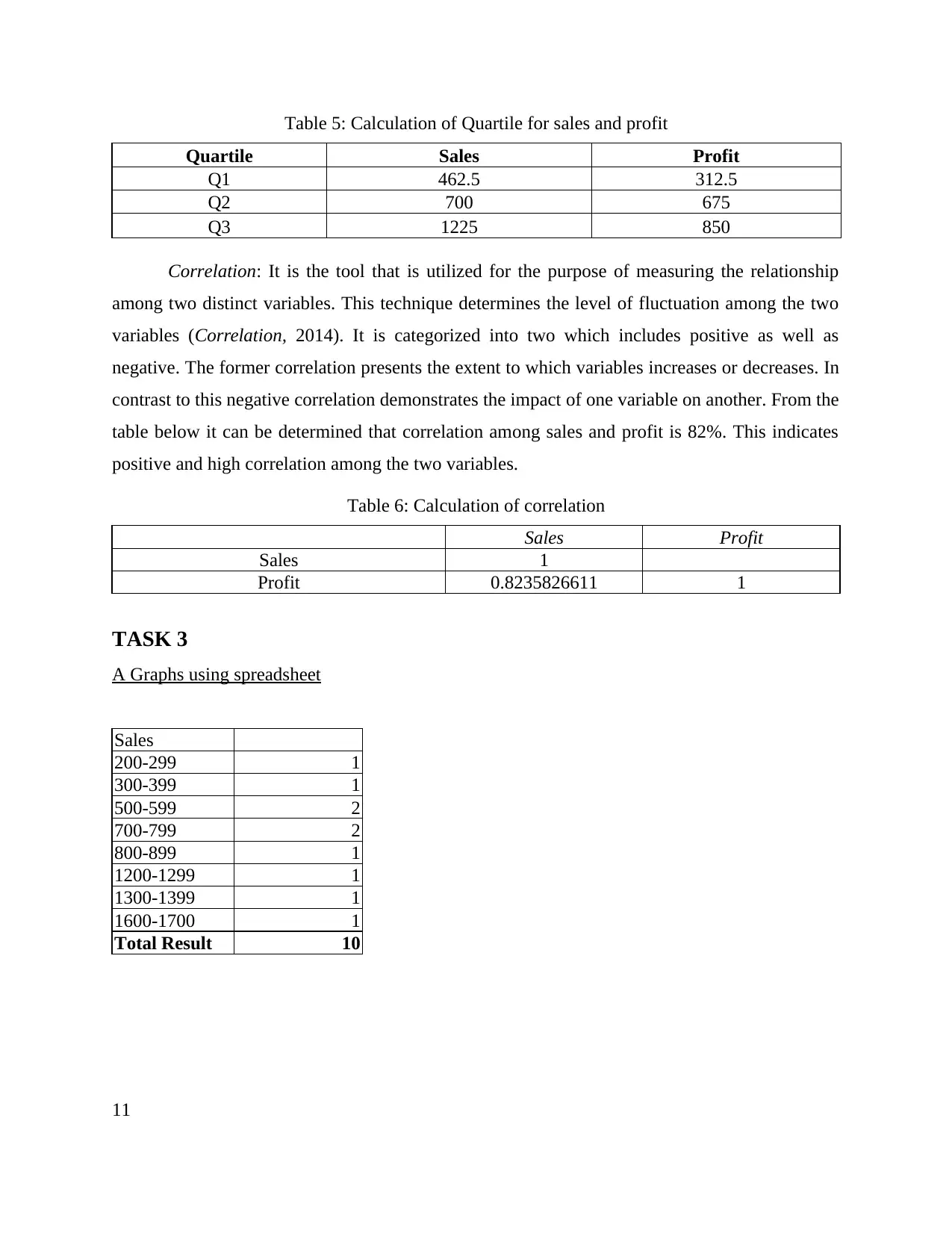
Table 5: Calculation of Quartile for sales and profit
Quartile Sales Profit
Q1 462.5 312.5
Q2 700 675
Q3 1225 850
Correlation: It is the tool that is utilized for the purpose of measuring the relationship
among two distinct variables. This technique determines the level of fluctuation among the two
variables (Correlation, 2014). It is categorized into two which includes positive as well as
negative. The former correlation presents the extent to which variables increases or decreases. In
contrast to this negative correlation demonstrates the impact of one variable on another. From the
table below it can be determined that correlation among sales and profit is 82%. This indicates
positive and high correlation among the two variables.
Table 6: Calculation of correlation
Sales Profit
Sales 1
Profit 0.8235826611 1
TASK 3
A Graphs using spreadsheet
Sales
200-299 1
300-399 1
500-599 2
700-799 2
800-899 1
1200-1299 1
1300-1399 1
1600-1700 1
Total Result 10
11
Quartile Sales Profit
Q1 462.5 312.5
Q2 700 675
Q3 1225 850
Correlation: It is the tool that is utilized for the purpose of measuring the relationship
among two distinct variables. This technique determines the level of fluctuation among the two
variables (Correlation, 2014). It is categorized into two which includes positive as well as
negative. The former correlation presents the extent to which variables increases or decreases. In
contrast to this negative correlation demonstrates the impact of one variable on another. From the
table below it can be determined that correlation among sales and profit is 82%. This indicates
positive and high correlation among the two variables.
Table 6: Calculation of correlation
Sales Profit
Sales 1
Profit 0.8235826611 1
TASK 3
A Graphs using spreadsheet
Sales
200-299 1
300-399 1
500-599 2
700-799 2
800-899 1
1200-1299 1
1300-1399 1
1600-1700 1
Total Result 10
11

The histogram presents the times when similar sales variables emerges in a particular
range. The graph reflected above presents that the sales between 500-599 and 700-799 has been
incurred by fresh juice manufacturers for 2 times. However in other ranges the sales has occurred
once.
Profit
100-199 1
200-299 1
300-399 1
600-699 2
700-799 1
800-899 2
1000-1099 1
1400-1500 1
Total Result 10
12
200-299
300-399
500-599
700-799
800-899
1200-1299
1300-1399
1600-1700
Total Result
024681012
Histogram of Sales
Series1
range. The graph reflected above presents that the sales between 500-599 and 700-799 has been
incurred by fresh juice manufacturers for 2 times. However in other ranges the sales has occurred
once.
Profit
100-199 1
200-299 1
300-399 1
600-699 2
700-799 1
800-899 2
1000-1099 1
1400-1500 1
Total Result 10
12
200-299
300-399
500-599
700-799
800-899
1200-1299
1300-1399
1600-1700
Total Result
024681012
Histogram of Sales
Series1
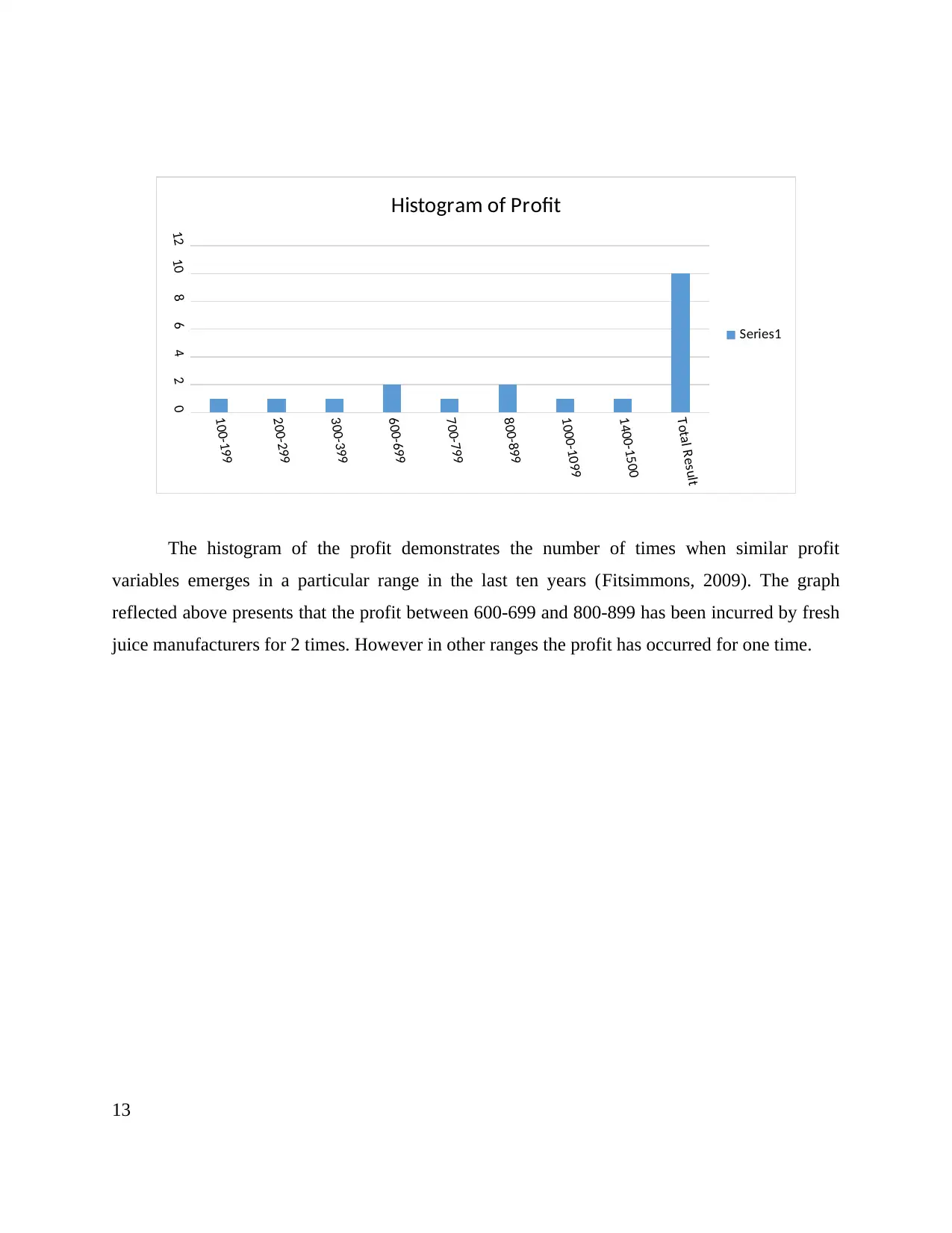
The histogram of the profit demonstrates the number of times when similar profit
variables emerges in a particular range in the last ten years (Fitsimmons, 2009). The graph
reflected above presents that the profit between 600-699 and 800-899 has been incurred by fresh
juice manufacturers for 2 times. However in other ranges the profit has occurred for one time.
13
100-199
200-299
300-399
600-699
700-799
800-899
1000-1099
1400-1500
Total Result
024681012
Histogram of Profit
Series1
variables emerges in a particular range in the last ten years (Fitsimmons, 2009). The graph
reflected above presents that the profit between 600-699 and 800-899 has been incurred by fresh
juice manufacturers for 2 times. However in other ranges the profit has occurred for one time.
13
100-199
200-299
300-399
600-699
700-799
800-899
1000-1099
1400-1500
Total Result
024681012
Histogram of Profit
Series1
Paraphrase This Document
Need a fresh take? Get an instant paraphrase of this document with our AI Paraphraser
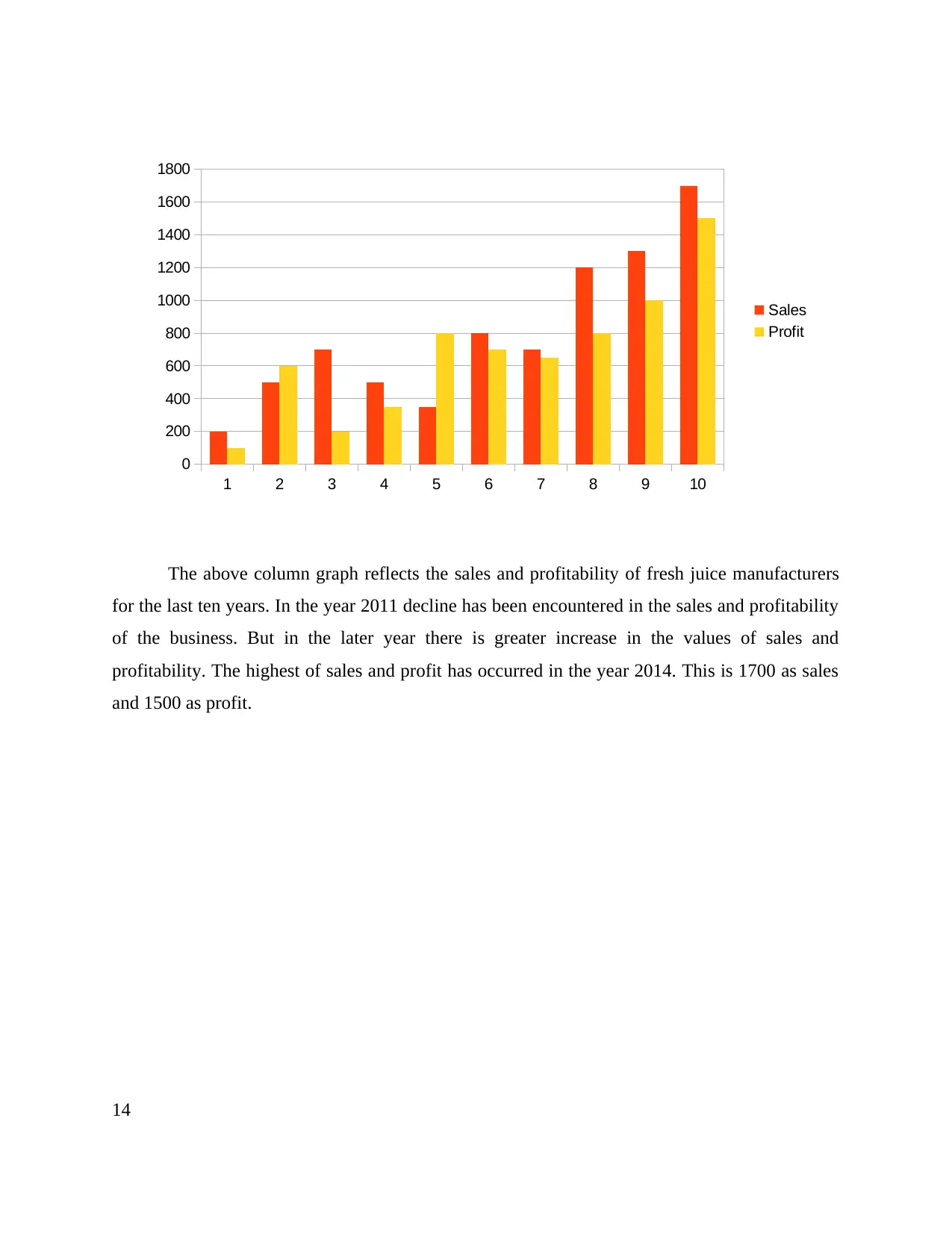
The above column graph reflects the sales and profitability of fresh juice manufacturers
for the last ten years. In the year 2011 decline has been encountered in the sales and profitability
of the business. But in the later year there is greater increase in the values of sales and
profitability. The highest of sales and profit has occurred in the year 2014. This is 1700 as sales
and 1500 as profit.
14
1 2 3 4 5 6 7 8 9 10
0
200
400
600
800
1000
1200
1400
1600
1800
Sales
Profit
for the last ten years. In the year 2011 decline has been encountered in the sales and profitability
of the business. But in the later year there is greater increase in the values of sales and
profitability. The highest of sales and profit has occurred in the year 2014. This is 1700 as sales
and 1500 as profit.
14
1 2 3 4 5 6 7 8 9 10
0
200
400
600
800
1000
1200
1400
1600
1800
Sales
Profit
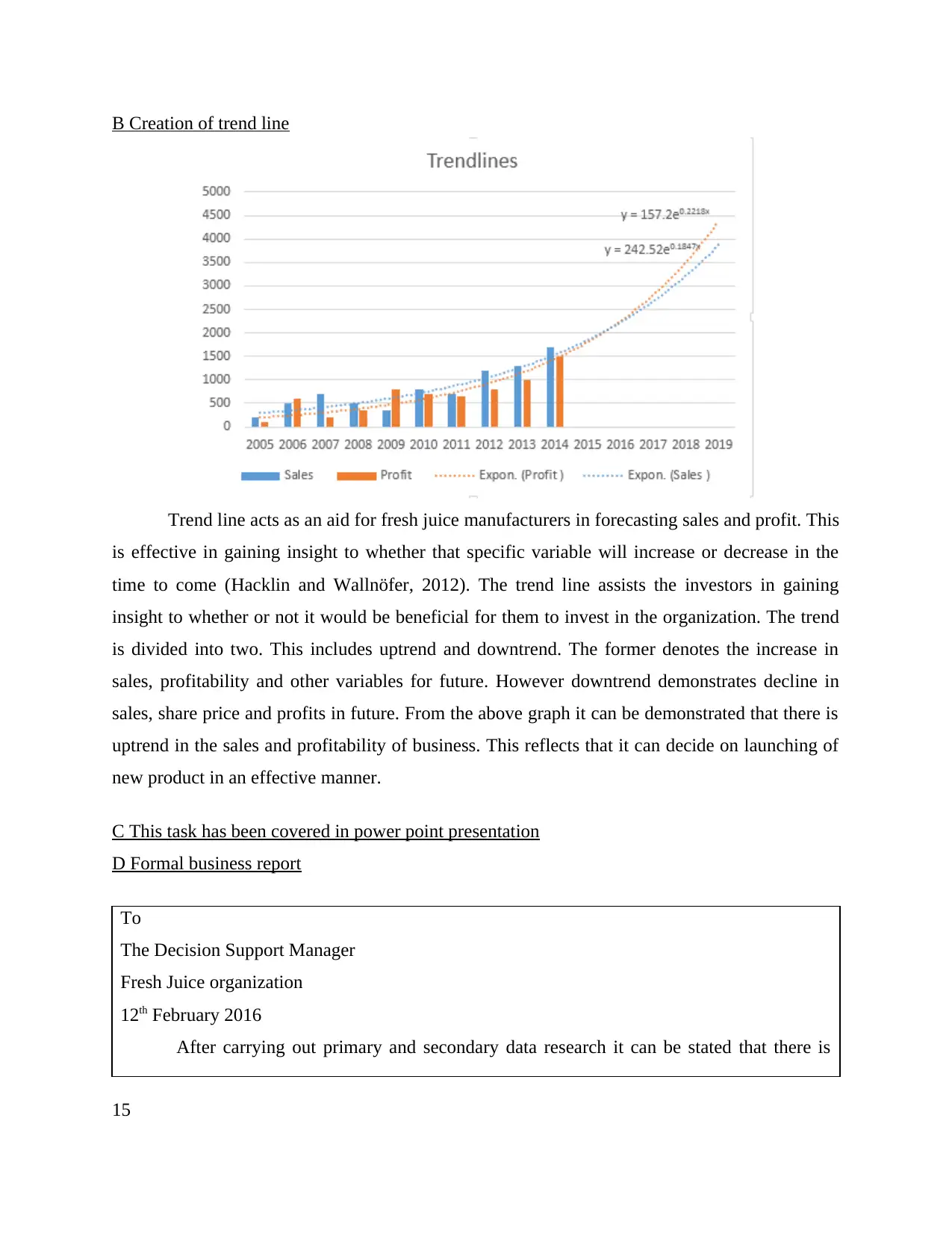
B Creation of trend line
Trend line acts as an aid for fresh juice manufacturers in forecasting sales and profit. This
is effective in gaining insight to whether that specific variable will increase or decrease in the
time to come (Hacklin and Wallnöfer, 2012). The trend line assists the investors in gaining
insight to whether or not it would be beneficial for them to invest in the organization. The trend
is divided into two. This includes uptrend and downtrend. The former denotes the increase in
sales, profitability and other variables for future. However downtrend demonstrates decline in
sales, share price and profits in future. From the above graph it can be demonstrated that there is
uptrend in the sales and profitability of business. This reflects that it can decide on launching of
new product in an effective manner.
C This task has been covered in power point presentation
D Formal business report
To
The Decision Support Manager
Fresh Juice organization
12th February 2016
After carrying out primary and secondary data research it can be stated that there is
15
Trend line acts as an aid for fresh juice manufacturers in forecasting sales and profit. This
is effective in gaining insight to whether that specific variable will increase or decrease in the
time to come (Hacklin and Wallnöfer, 2012). The trend line assists the investors in gaining
insight to whether or not it would be beneficial for them to invest in the organization. The trend
is divided into two. This includes uptrend and downtrend. The former denotes the increase in
sales, profitability and other variables for future. However downtrend demonstrates decline in
sales, share price and profits in future. From the above graph it can be demonstrated that there is
uptrend in the sales and profitability of business. This reflects that it can decide on launching of
new product in an effective manner.
C This task has been covered in power point presentation
D Formal business report
To
The Decision Support Manager
Fresh Juice organization
12th February 2016
After carrying out primary and secondary data research it can be stated that there is
15
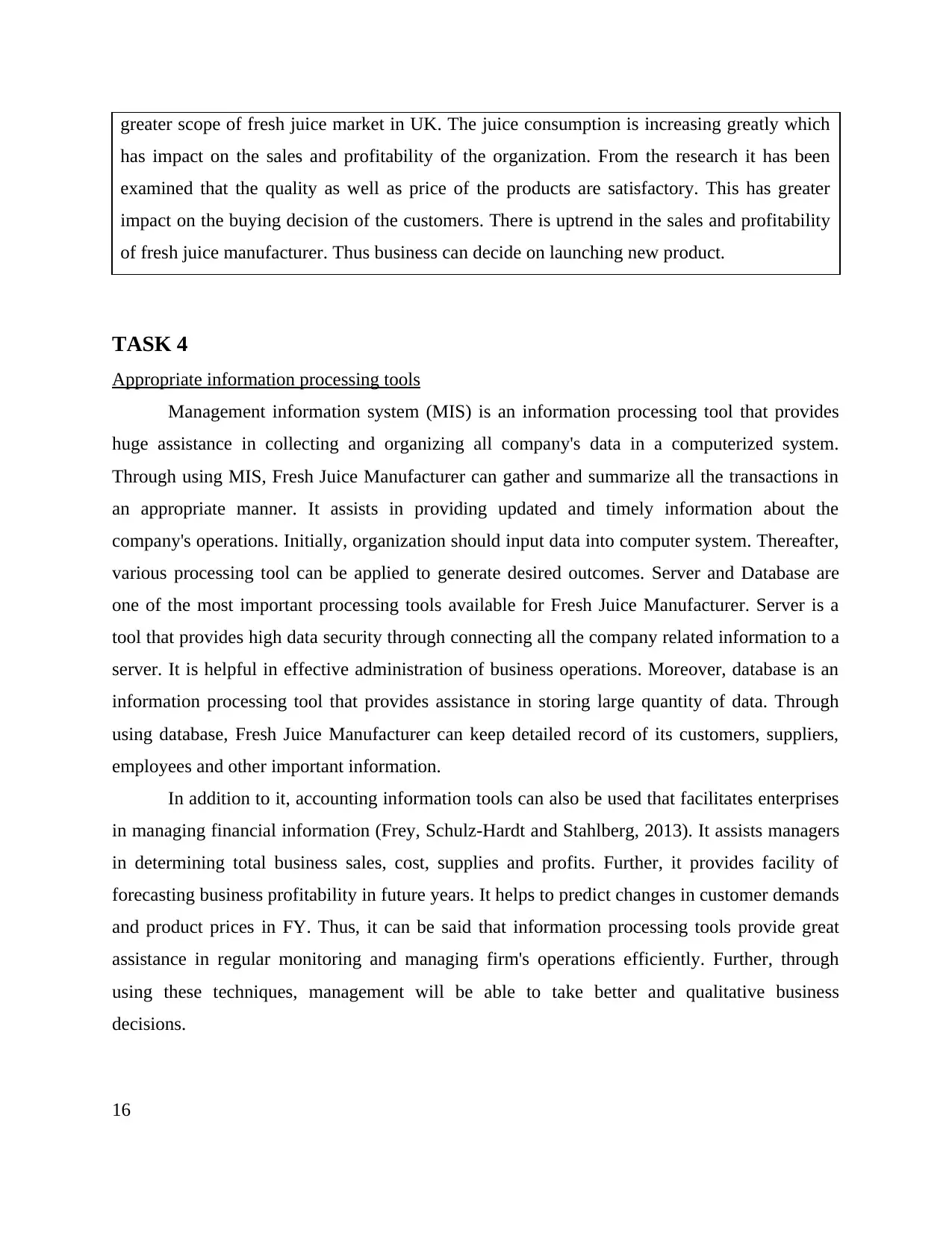
greater scope of fresh juice market in UK. The juice consumption is increasing greatly which
has impact on the sales and profitability of the organization. From the research it has been
examined that the quality as well as price of the products are satisfactory. This has greater
impact on the buying decision of the customers. There is uptrend in the sales and profitability
of fresh juice manufacturer. Thus business can decide on launching new product.
TASK 4
Appropriate information processing tools
Management information system (MIS) is an information processing tool that provides
huge assistance in collecting and organizing all company's data in a computerized system.
Through using MIS, Fresh Juice Manufacturer can gather and summarize all the transactions in
an appropriate manner. It assists in providing updated and timely information about the
company's operations. Initially, organization should input data into computer system. Thereafter,
various processing tool can be applied to generate desired outcomes. Server and Database are
one of the most important processing tools available for Fresh Juice Manufacturer. Server is a
tool that provides high data security through connecting all the company related information to a
server. It is helpful in effective administration of business operations. Moreover, database is an
information processing tool that provides assistance in storing large quantity of data. Through
using database, Fresh Juice Manufacturer can keep detailed record of its customers, suppliers,
employees and other important information.
In addition to it, accounting information tools can also be used that facilitates enterprises
in managing financial information (Frey, Schulz-Hardt and Stahlberg, 2013). It assists managers
in determining total business sales, cost, supplies and profits. Further, it provides facility of
forecasting business profitability in future years. It helps to predict changes in customer demands
and product prices in FY. Thus, it can be said that information processing tools provide great
assistance in regular monitoring and managing firm's operations efficiently. Further, through
using these techniques, management will be able to take better and qualitative business
decisions.
16
has impact on the sales and profitability of the organization. From the research it has been
examined that the quality as well as price of the products are satisfactory. This has greater
impact on the buying decision of the customers. There is uptrend in the sales and profitability
of fresh juice manufacturer. Thus business can decide on launching new product.
TASK 4
Appropriate information processing tools
Management information system (MIS) is an information processing tool that provides
huge assistance in collecting and organizing all company's data in a computerized system.
Through using MIS, Fresh Juice Manufacturer can gather and summarize all the transactions in
an appropriate manner. It assists in providing updated and timely information about the
company's operations. Initially, organization should input data into computer system. Thereafter,
various processing tool can be applied to generate desired outcomes. Server and Database are
one of the most important processing tools available for Fresh Juice Manufacturer. Server is a
tool that provides high data security through connecting all the company related information to a
server. It is helpful in effective administration of business operations. Moreover, database is an
information processing tool that provides assistance in storing large quantity of data. Through
using database, Fresh Juice Manufacturer can keep detailed record of its customers, suppliers,
employees and other important information.
In addition to it, accounting information tools can also be used that facilitates enterprises
in managing financial information (Frey, Schulz-Hardt and Stahlberg, 2013). It assists managers
in determining total business sales, cost, supplies and profits. Further, it provides facility of
forecasting business profitability in future years. It helps to predict changes in customer demands
and product prices in FY. Thus, it can be said that information processing tools provide great
assistance in regular monitoring and managing firm's operations efficiently. Further, through
using these techniques, management will be able to take better and qualitative business
decisions.
16
Secure Best Marks with AI Grader
Need help grading? Try our AI Grader for instant feedback on your assignments.
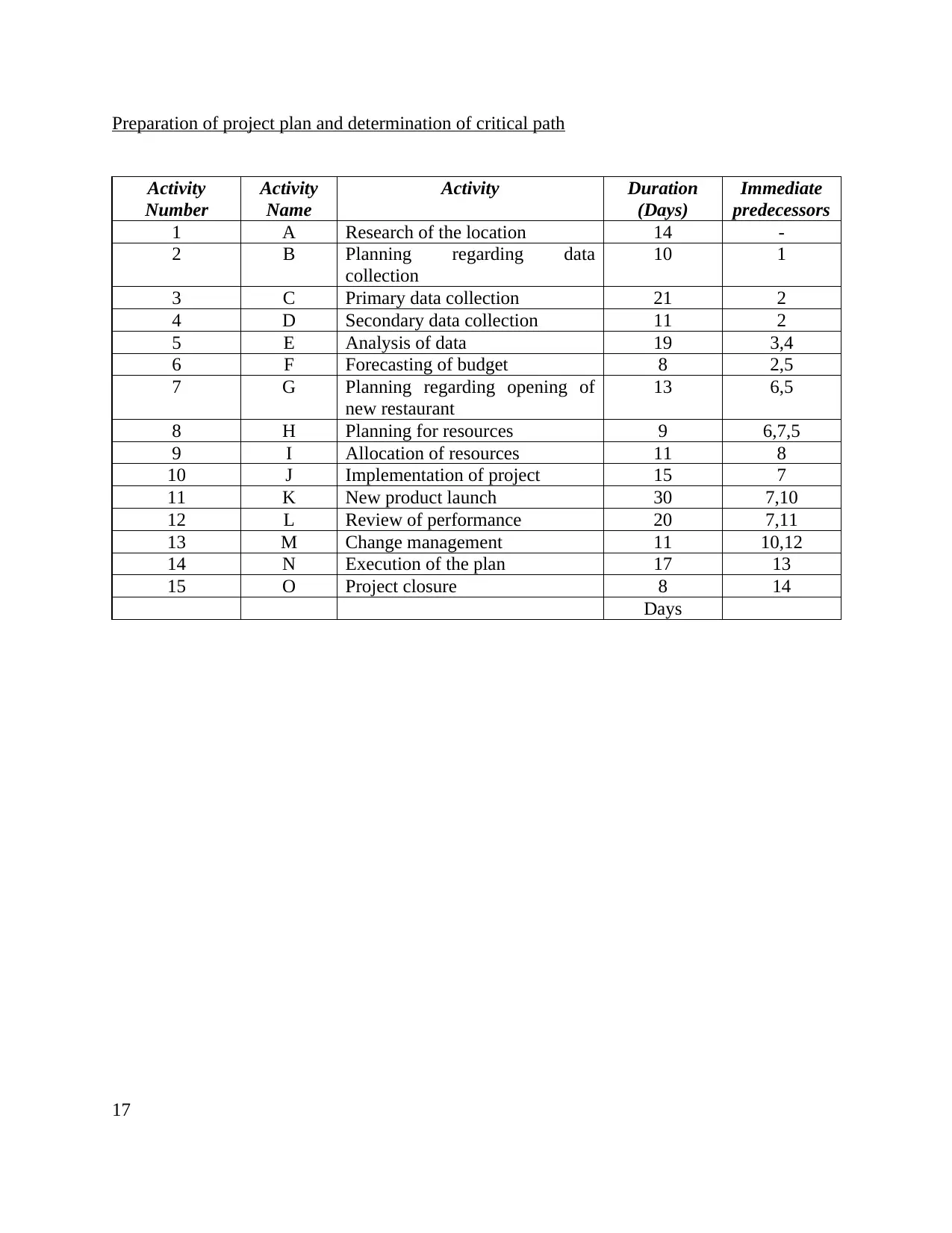
Preparation of project plan and determination of critical path
Activity
Number
Activity
Name
Activity Duration
(Days)
Immediate
predecessors
1 A Research of the location 14 -
2 B Planning regarding data
collection
10 1
3 C Primary data collection 21 2
4 D Secondary data collection 11 2
5 E Analysis of data 19 3,4
6 F Forecasting of budget 8 2,5
7 G Planning regarding opening of
new restaurant
13 6,5
8 H Planning for resources 9 6,7,5
9 I Allocation of resources 11 8
10 J Implementation of project 15 7
11 K New product launch 30 7,10
12 L Review of performance 20 7,11
13 M Change management 11 10,12
14 N Execution of the plan 17 13
15 O Project closure 8 14
Days
17
Activity
Number
Activity
Name
Activity Duration
(Days)
Immediate
predecessors
1 A Research of the location 14 -
2 B Planning regarding data
collection
10 1
3 C Primary data collection 21 2
4 D Secondary data collection 11 2
5 E Analysis of data 19 3,4
6 F Forecasting of budget 8 2,5
7 G Planning regarding opening of
new restaurant
13 6,5
8 H Planning for resources 9 6,7,5
9 I Allocation of resources 11 8
10 J Implementation of project 15 7
11 K New product launch 30 7,10
12 L Review of performance 20 7,11
13 M Change management 11 10,12
14 N Execution of the plan 17 13
15 O Project closure 8 14
Days
17
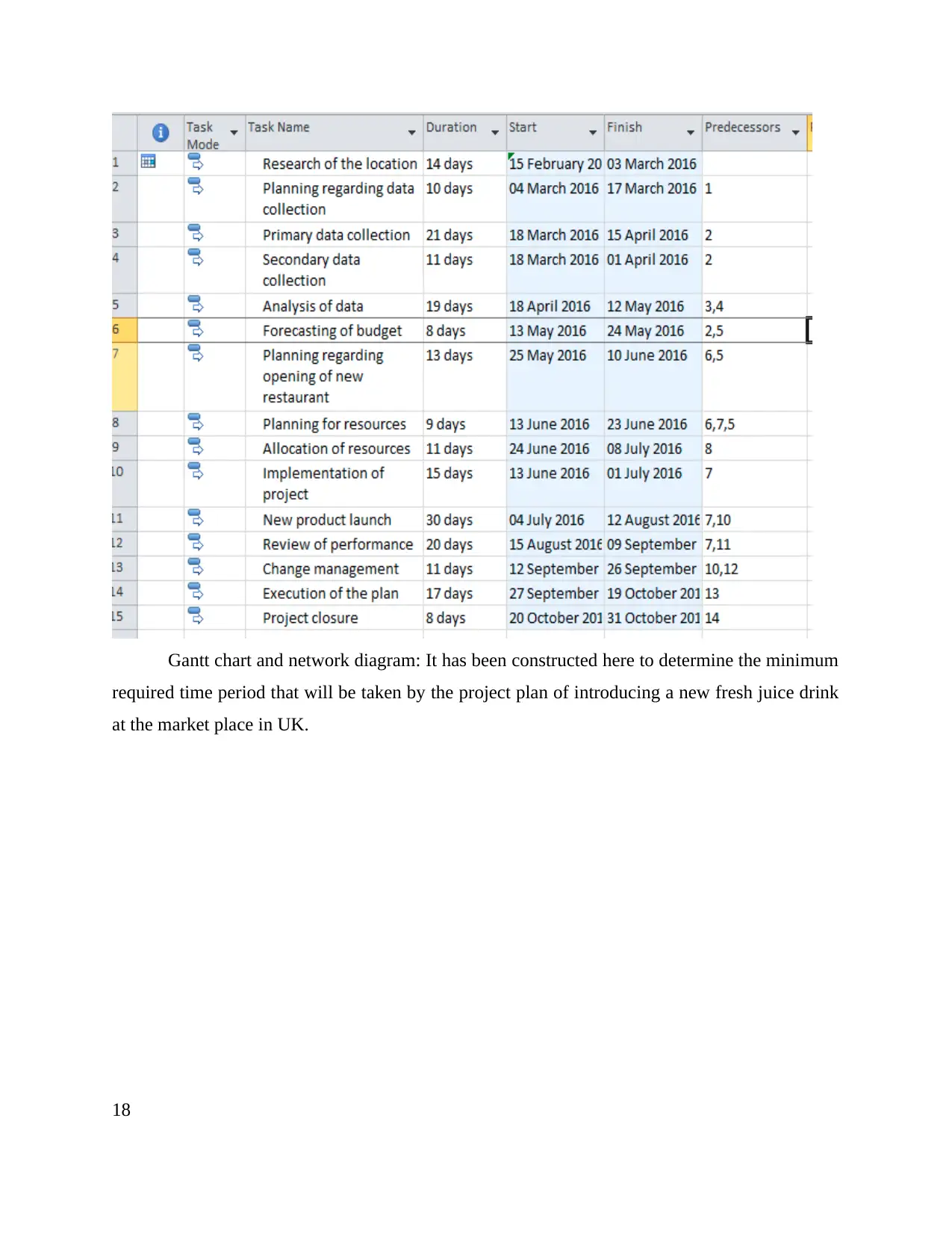
Gantt chart and network diagram: It has been constructed here to determine the minimum
required time period that will be taken by the project plan of introducing a new fresh juice drink
at the market place in UK.
18
required time period that will be taken by the project plan of introducing a new fresh juice drink
at the market place in UK.
18
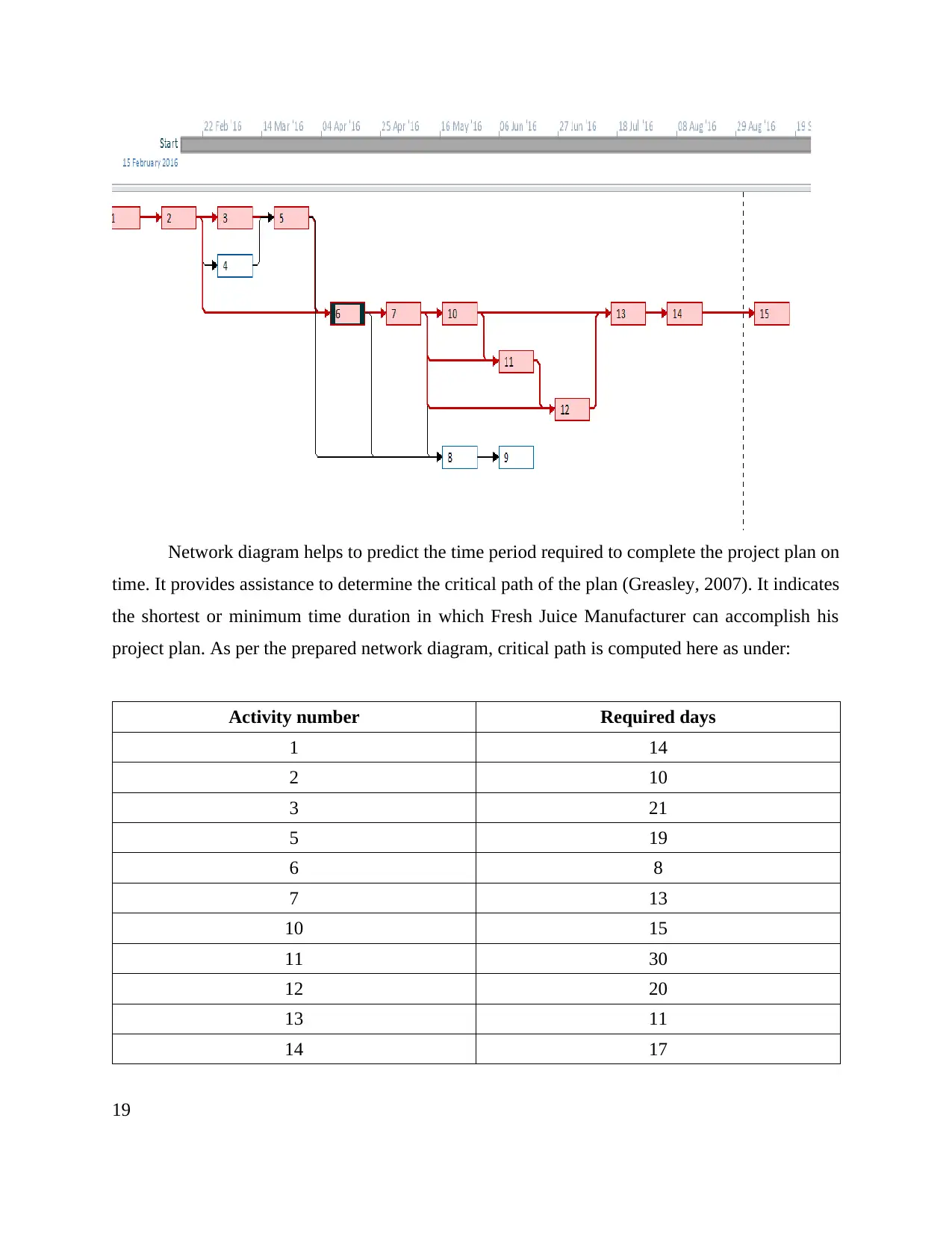
Network diagram helps to predict the time period required to complete the project plan on
time. It provides assistance to determine the critical path of the plan (Greasley, 2007). It indicates
the shortest or minimum time duration in which Fresh Juice Manufacturer can accomplish his
project plan. As per the prepared network diagram, critical path is computed here as under:
Activity number Required days
1 14
2 10
3 21
5 19
6 8
7 13
10 15
11 30
12 20
13 11
14 17
19
time. It provides assistance to determine the critical path of the plan (Greasley, 2007). It indicates
the shortest or minimum time duration in which Fresh Juice Manufacturer can accomplish his
project plan. As per the prepared network diagram, critical path is computed here as under:
Activity number Required days
1 14
2 10
3 21
5 19
6 8
7 13
10 15
11 30
12 20
13 11
14 17
19
Paraphrase This Document
Need a fresh take? Get an instant paraphrase of this document with our AI Paraphraser
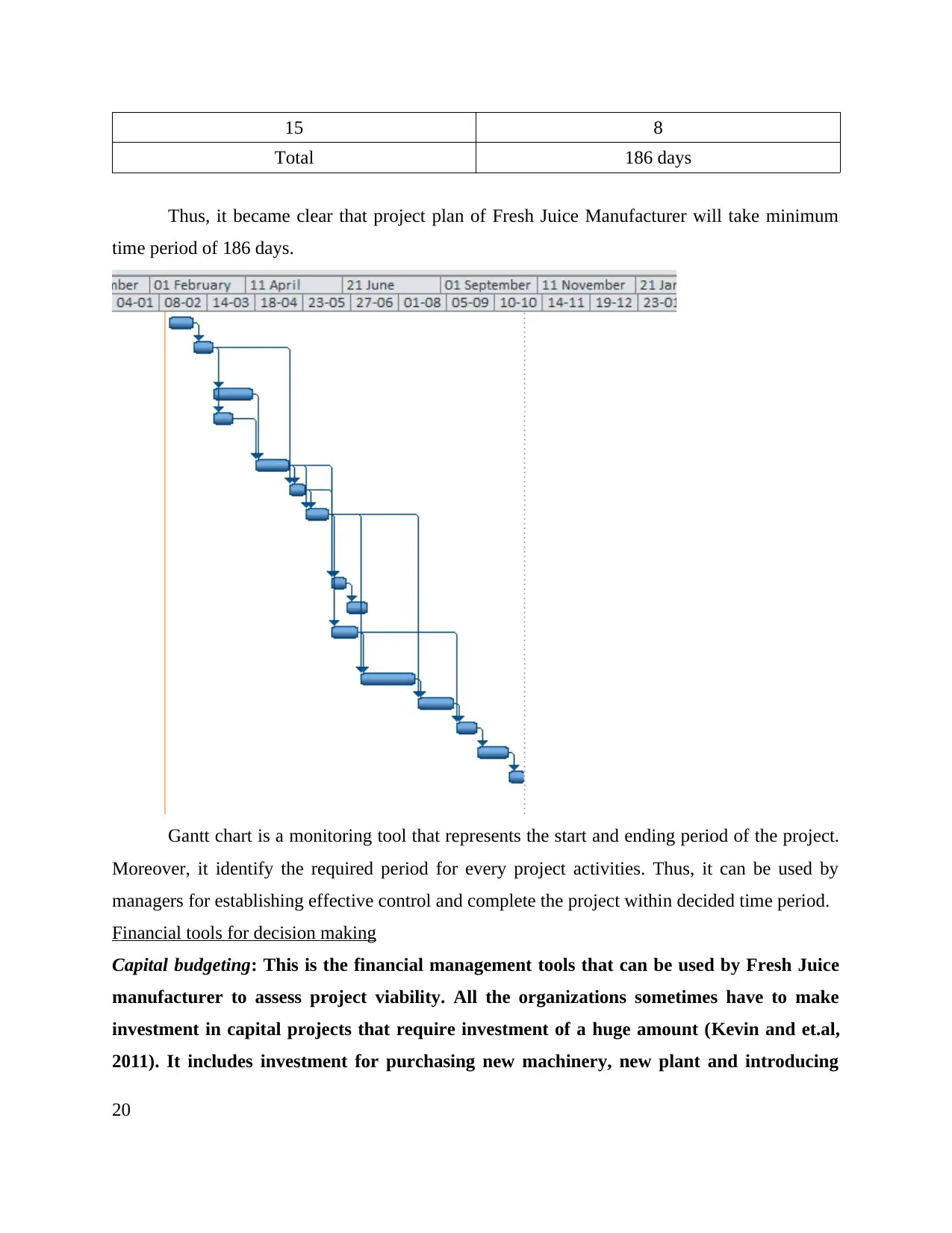
15 8
Total 186 days
Thus, it became clear that project plan of Fresh Juice Manufacturer will take minimum
time period of 186 days.
Gantt chart is a monitoring tool that represents the start and ending period of the project.
Moreover, it identify the required period for every project activities. Thus, it can be used by
managers for establishing effective control and complete the project within decided time period.
Financial tools for decision making
Capital budgeting: This is the financial management tools that can be used by Fresh Juice
manufacturer to assess project viability. All the organizations sometimes have to make
investment in capital projects that require investment of a huge amount (Kevin and et.al,
2011). It includes investment for purchasing new machinery, new plant and introducing
20
Total 186 days
Thus, it became clear that project plan of Fresh Juice Manufacturer will take minimum
time period of 186 days.
Gantt chart is a monitoring tool that represents the start and ending period of the project.
Moreover, it identify the required period for every project activities. Thus, it can be used by
managers for establishing effective control and complete the project within decided time period.
Financial tools for decision making
Capital budgeting: This is the financial management tools that can be used by Fresh Juice
manufacturer to assess project viability. All the organizations sometimes have to make
investment in capital projects that require investment of a huge amount (Kevin and et.al,
2011). It includes investment for purchasing new machinery, new plant and introducing
20
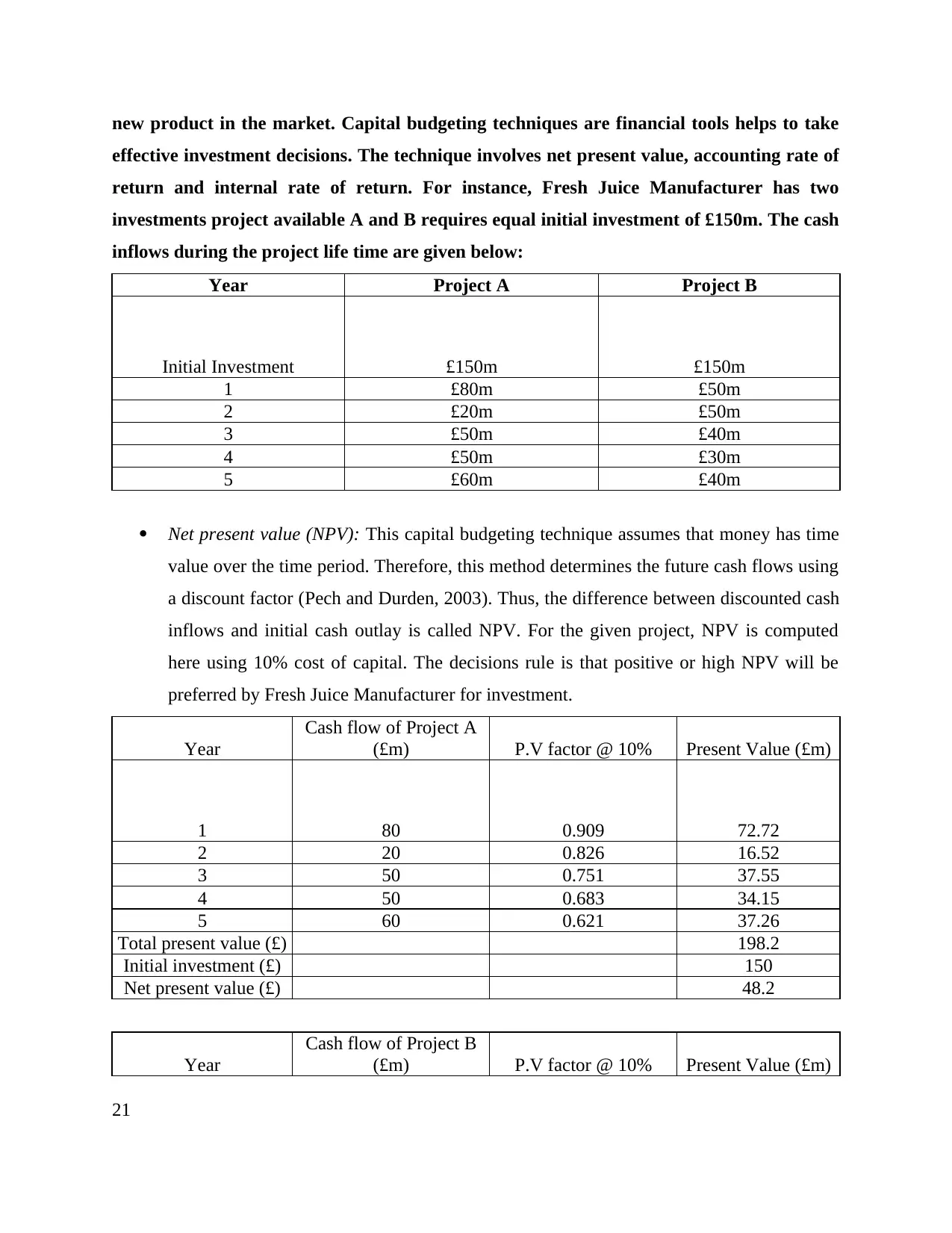
new product in the market. Capital budgeting techniques are financial tools helps to take
effective investment decisions. The technique involves net present value, accounting rate of
return and internal rate of return. For instance, Fresh Juice Manufacturer has two
investments project available A and B requires equal initial investment of £150m. The cash
inflows during the project life time are given below:
Year Project A Project B
Initial Investment £150m £150m
1 £80m £50m
2 £20m £50m
3 £50m £40m
4 £50m £30m
5 £60m £40m
Net present value (NPV): This capital budgeting technique assumes that money has time
value over the time period. Therefore, this method determines the future cash flows using
a discount factor (Pech and Durden, 2003). Thus, the difference between discounted cash
inflows and initial cash outlay is called NPV. For the given project, NPV is computed
here using 10% cost of capital. The decisions rule is that positive or high NPV will be
preferred by Fresh Juice Manufacturer for investment.
Year
Cash flow of Project A
(£m) P.V factor @ 10% Present Value (£m)
1 80 0.909 72.72
2 20 0.826 16.52
3 50 0.751 37.55
4 50 0.683 34.15
5 60 0.621 37.26
Total present value (£) 198.2
Initial investment (£) 150
Net present value (£) 48.2
Year
Cash flow of Project B
(£m) P.V factor @ 10% Present Value (£m)
21
effective investment decisions. The technique involves net present value, accounting rate of
return and internal rate of return. For instance, Fresh Juice Manufacturer has two
investments project available A and B requires equal initial investment of £150m. The cash
inflows during the project life time are given below:
Year Project A Project B
Initial Investment £150m £150m
1 £80m £50m
2 £20m £50m
3 £50m £40m
4 £50m £30m
5 £60m £40m
Net present value (NPV): This capital budgeting technique assumes that money has time
value over the time period. Therefore, this method determines the future cash flows using
a discount factor (Pech and Durden, 2003). Thus, the difference between discounted cash
inflows and initial cash outlay is called NPV. For the given project, NPV is computed
here using 10% cost of capital. The decisions rule is that positive or high NPV will be
preferred by Fresh Juice Manufacturer for investment.
Year
Cash flow of Project A
(£m) P.V factor @ 10% Present Value (£m)
1 80 0.909 72.72
2 20 0.826 16.52
3 50 0.751 37.55
4 50 0.683 34.15
5 60 0.621 37.26
Total present value (£) 198.2
Initial investment (£) 150
Net present value (£) 48.2
Year
Cash flow of Project B
(£m) P.V factor @ 10% Present Value (£m)
21
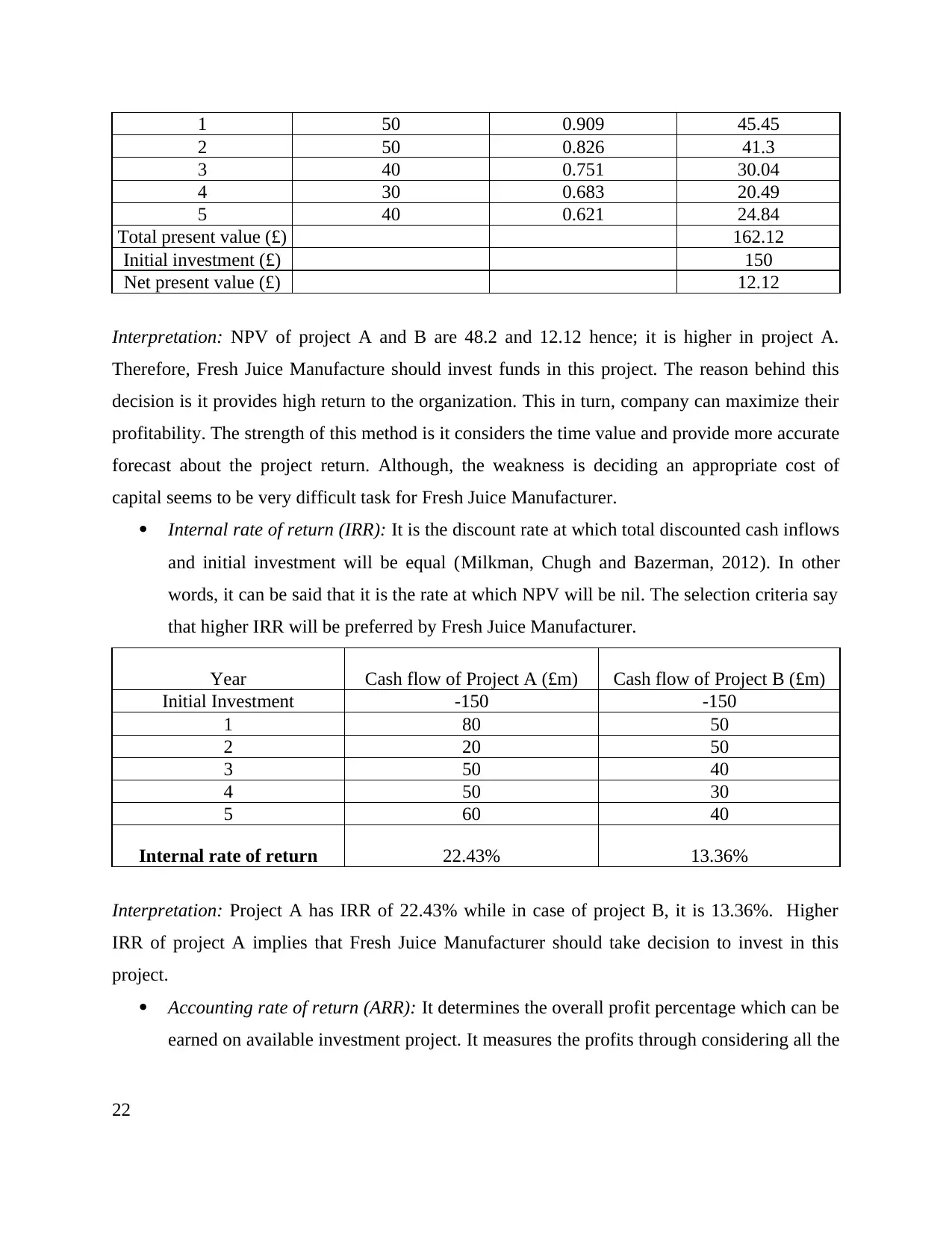
1 50 0.909 45.45
2 50 0.826 41.3
3 40 0.751 30.04
4 30 0.683 20.49
5 40 0.621 24.84
Total present value (£) 162.12
Initial investment (£) 150
Net present value (£) 12.12
Interpretation: NPV of project A and B are 48.2 and 12.12 hence; it is higher in project A.
Therefore, Fresh Juice Manufacture should invest funds in this project. The reason behind this
decision is it provides high return to the organization. This in turn, company can maximize their
profitability. The strength of this method is it considers the time value and provide more accurate
forecast about the project return. Although, the weakness is deciding an appropriate cost of
capital seems to be very difficult task for Fresh Juice Manufacturer.
Internal rate of return (IRR): It is the discount rate at which total discounted cash inflows
and initial investment will be equal (Milkman, Chugh and Bazerman, 2012). In other
words, it can be said that it is the rate at which NPV will be nil. The selection criteria say
that higher IRR will be preferred by Fresh Juice Manufacturer.
Year Cash flow of Project A (£m) Cash flow of Project B (£m)
Initial Investment -150 -150
1 80 50
2 20 50
3 50 40
4 50 30
5 60 40
Internal rate of return 22.43% 13.36%
Interpretation: Project A has IRR of 22.43% while in case of project B, it is 13.36%. Higher
IRR of project A implies that Fresh Juice Manufacturer should take decision to invest in this
project.
Accounting rate of return (ARR): It determines the overall profit percentage which can be
earned on available investment project. It measures the profits through considering all the
22
2 50 0.826 41.3
3 40 0.751 30.04
4 30 0.683 20.49
5 40 0.621 24.84
Total present value (£) 162.12
Initial investment (£) 150
Net present value (£) 12.12
Interpretation: NPV of project A and B are 48.2 and 12.12 hence; it is higher in project A.
Therefore, Fresh Juice Manufacture should invest funds in this project. The reason behind this
decision is it provides high return to the organization. This in turn, company can maximize their
profitability. The strength of this method is it considers the time value and provide more accurate
forecast about the project return. Although, the weakness is deciding an appropriate cost of
capital seems to be very difficult task for Fresh Juice Manufacturer.
Internal rate of return (IRR): It is the discount rate at which total discounted cash inflows
and initial investment will be equal (Milkman, Chugh and Bazerman, 2012). In other
words, it can be said that it is the rate at which NPV will be nil. The selection criteria say
that higher IRR will be preferred by Fresh Juice Manufacturer.
Year Cash flow of Project A (£m) Cash flow of Project B (£m)
Initial Investment -150 -150
1 80 50
2 20 50
3 50 40
4 50 30
5 60 40
Internal rate of return 22.43% 13.36%
Interpretation: Project A has IRR of 22.43% while in case of project B, it is 13.36%. Higher
IRR of project A implies that Fresh Juice Manufacturer should take decision to invest in this
project.
Accounting rate of return (ARR): It determines the overall profit percentage which can be
earned on available investment project. It measures the profits through considering all the
22
Secure Best Marks with AI Grader
Need help grading? Try our AI Grader for instant feedback on your assignments.
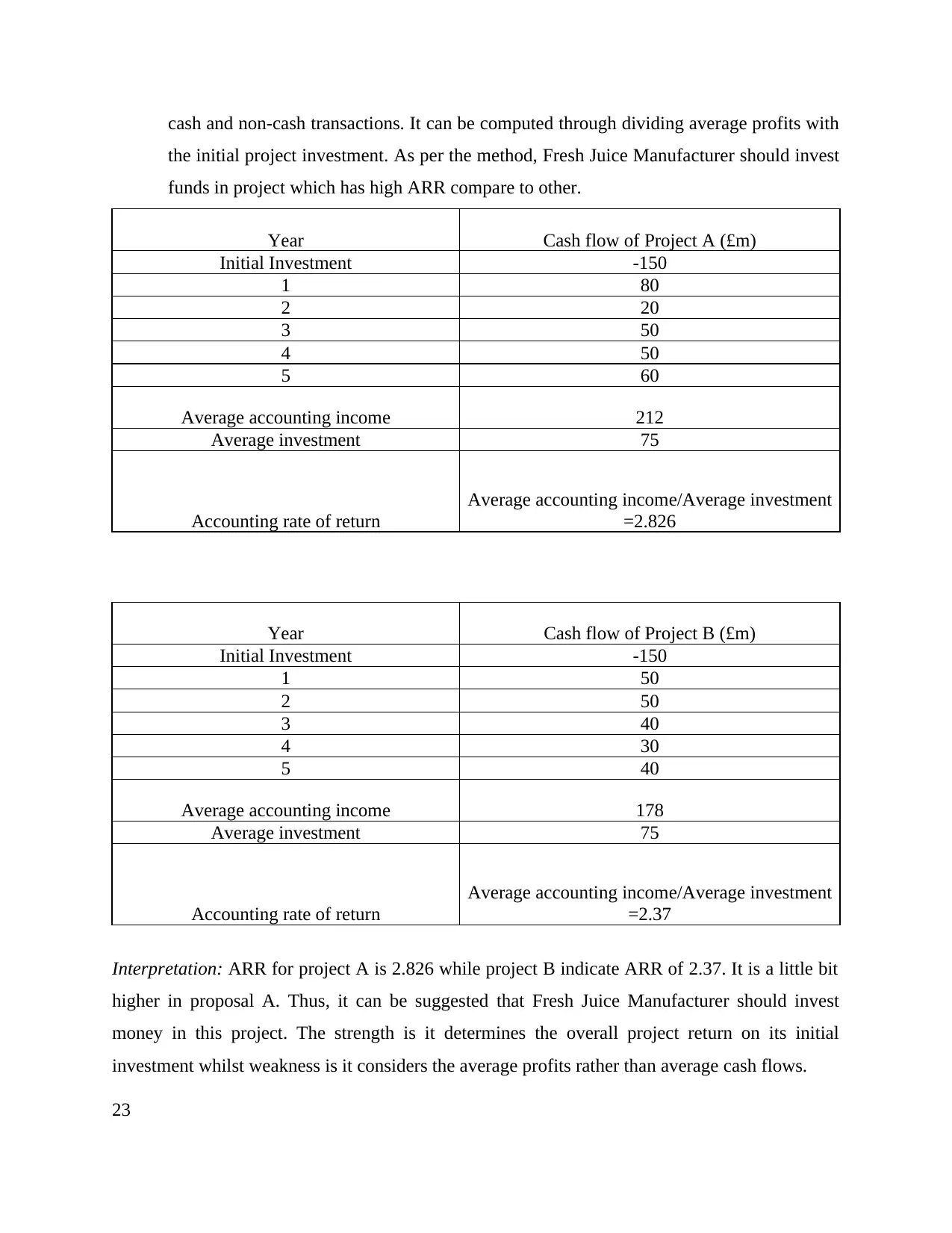
cash and non-cash transactions. It can be computed through dividing average profits with
the initial project investment. As per the method, Fresh Juice Manufacturer should invest
funds in project which has high ARR compare to other.
Year Cash flow of Project A (£m)
Initial Investment -150
1 80
2 20
3 50
4 50
5 60
Average accounting income 212
Average investment 75
Accounting rate of return
Average accounting income/Average investment
=2.826
Year Cash flow of Project B (£m)
Initial Investment -150
1 50
2 50
3 40
4 30
5 40
Average accounting income 178
Average investment 75
Accounting rate of return
Average accounting income/Average investment
=2.37
Interpretation: ARR for project A is 2.826 while project B indicate ARR of 2.37. It is a little bit
higher in proposal A. Thus, it can be suggested that Fresh Juice Manufacturer should invest
money in this project. The strength is it determines the overall project return on its initial
investment whilst weakness is it considers the average profits rather than average cash flows.
23
the initial project investment. As per the method, Fresh Juice Manufacturer should invest
funds in project which has high ARR compare to other.
Year Cash flow of Project A (£m)
Initial Investment -150
1 80
2 20
3 50
4 50
5 60
Average accounting income 212
Average investment 75
Accounting rate of return
Average accounting income/Average investment
=2.826
Year Cash flow of Project B (£m)
Initial Investment -150
1 50
2 50
3 40
4 30
5 40
Average accounting income 178
Average investment 75
Accounting rate of return
Average accounting income/Average investment
=2.37
Interpretation: ARR for project A is 2.826 while project B indicate ARR of 2.37. It is a little bit
higher in proposal A. Thus, it can be suggested that Fresh Juice Manufacturer should invest
money in this project. The strength is it determines the overall project return on its initial
investment whilst weakness is it considers the average profits rather than average cash flows.
23
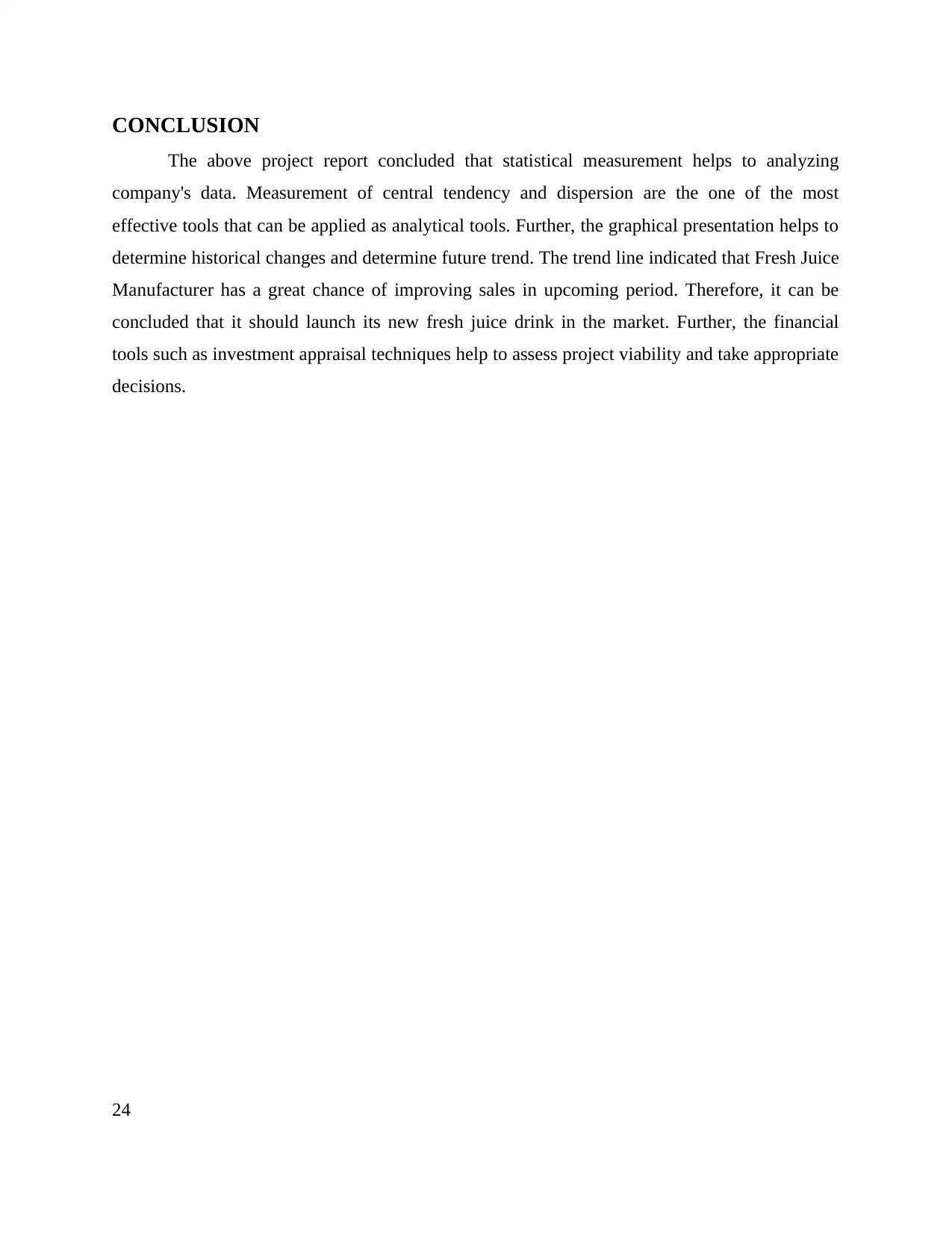
CONCLUSION
The above project report concluded that statistical measurement helps to analyzing
company's data. Measurement of central tendency and dispersion are the one of the most
effective tools that can be applied as analytical tools. Further, the graphical presentation helps to
determine historical changes and determine future trend. The trend line indicated that Fresh Juice
Manufacturer has a great chance of improving sales in upcoming period. Therefore, it can be
concluded that it should launch its new fresh juice drink in the market. Further, the financial
tools such as investment appraisal techniques help to assess project viability and take appropriate
decisions.
24
The above project report concluded that statistical measurement helps to analyzing
company's data. Measurement of central tendency and dispersion are the one of the most
effective tools that can be applied as analytical tools. Further, the graphical presentation helps to
determine historical changes and determine future trend. The trend line indicated that Fresh Juice
Manufacturer has a great chance of improving sales in upcoming period. Therefore, it can be
concluded that it should launch its new fresh juice drink in the market. Further, the financial
tools such as investment appraisal techniques help to assess project viability and take appropriate
decisions.
24

REFERENCES
Journals and Books
Coskun, S., Basligil, H. and Baracli, H., 2008. A weakness determination and analysis model for
business process improvement. Business Process Management Journal. 14(2). pp.243 - 261.
Cronan, T. P. and et.al., 2011. Decision making in an integrated business process context:
learning using an ERP simulation game. Decision Sciences Journal of Innovative Education.
9(2). pp. 227-234.
Fitsimmons, G., 2009. Resource management: materials, equipment, facilities. Bottom Line:
Managing Library Finances. 22(3). pp.86 -88.
Frey, D., Schulz-Hardt, S. and Stahlberg, D., 2013. Information seeking among individuals and
groups and possible consequences for decision-making in business and politics.
Understanding group behavior. 2. pp. 211-225.
Greasley, A., 2007. Operations Management. SAGE.
Hacklin, F. and Wallnöfer, M., 2012. Management Decision .The business model in the practice
of strategic decision making: insights from a case study. 50(2). pp.166–188.
Kevin, K. and et. al., 2011. Workforce and Finances of the United States Anesthesiology Training
Programs: 2009–2010. Anesthesia & Analgesia. 112(6). pp. 1480-1486.
Lucey, T., 2002. Quantitative Techniques. Cengage Learning.
Montier, J., 2010. Value Investing: Tools and Techniques for Intelligent Investment. John Wiley
& Sons.
Morato, A. E., 2013. Business Decision Making. eBookIt.com
Newbold, P. and et.al., 2009. Statistics for Business and Economics. Pearson Education.
Nicholson, B. and Aman, A., 2012. Managing attrition in offshore finance and accounting
outsourcing: Exploring the interplay of competing institutional logics. Strategic Outsourcing:
An International Journal. 5(3). pp 232 – 247.
Pech, R. J., and Durden, G., 2003. Management Decision. Manoeuvre warfare: a new military
paradigm for business decision making. 41(2). pp.168 – 179.
Rice, A. J., 2007. Mathematical Statistics and Data Analysis. Cengage Learning.
Online
25
Journals and Books
Coskun, S., Basligil, H. and Baracli, H., 2008. A weakness determination and analysis model for
business process improvement. Business Process Management Journal. 14(2). pp.243 - 261.
Cronan, T. P. and et.al., 2011. Decision making in an integrated business process context:
learning using an ERP simulation game. Decision Sciences Journal of Innovative Education.
9(2). pp. 227-234.
Fitsimmons, G., 2009. Resource management: materials, equipment, facilities. Bottom Line:
Managing Library Finances. 22(3). pp.86 -88.
Frey, D., Schulz-Hardt, S. and Stahlberg, D., 2013. Information seeking among individuals and
groups and possible consequences for decision-making in business and politics.
Understanding group behavior. 2. pp. 211-225.
Greasley, A., 2007. Operations Management. SAGE.
Hacklin, F. and Wallnöfer, M., 2012. Management Decision .The business model in the practice
of strategic decision making: insights from a case study. 50(2). pp.166–188.
Kevin, K. and et. al., 2011. Workforce and Finances of the United States Anesthesiology Training
Programs: 2009–2010. Anesthesia & Analgesia. 112(6). pp. 1480-1486.
Lucey, T., 2002. Quantitative Techniques. Cengage Learning.
Montier, J., 2010. Value Investing: Tools and Techniques for Intelligent Investment. John Wiley
& Sons.
Morato, A. E., 2013. Business Decision Making. eBookIt.com
Newbold, P. and et.al., 2009. Statistics for Business and Economics. Pearson Education.
Nicholson, B. and Aman, A., 2012. Managing attrition in offshore finance and accounting
outsourcing: Exploring the interplay of competing institutional logics. Strategic Outsourcing:
An International Journal. 5(3). pp 232 – 247.
Pech, R. J., and Durden, G., 2003. Management Decision. Manoeuvre warfare: a new military
paradigm for business decision making. 41(2). pp.168 – 179.
Rice, A. J., 2007. Mathematical Statistics and Data Analysis. Cengage Learning.
Online
25
1 out of 25
Related Documents
Your All-in-One AI-Powered Toolkit for Academic Success.
+13062052269
info@desklib.com
Available 24*7 on WhatsApp / Email
![[object Object]](/_next/static/media/star-bottom.7253800d.svg)
Unlock your academic potential
© 2024 | Zucol Services PVT LTD | All rights reserved.





